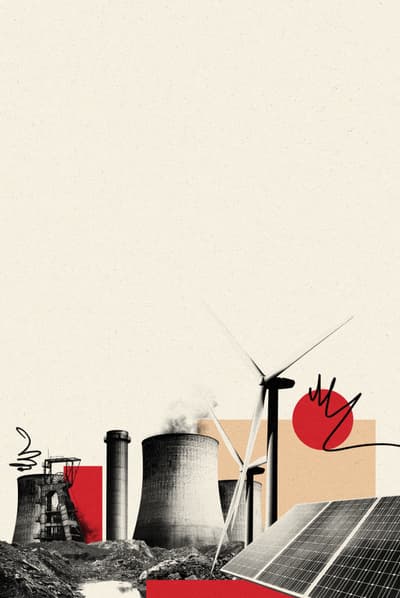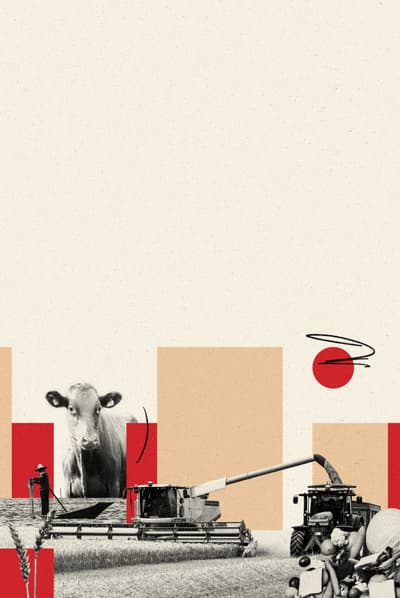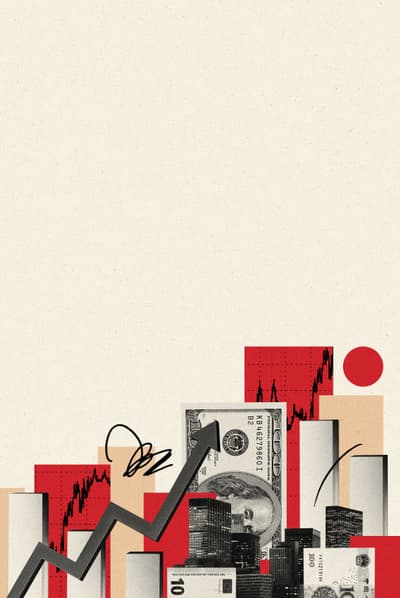In the salt flats of Gujarat, India, an unlikely green revolution is underway. With support from trade union SEWA, thousands of informal salt farmers are swapping diesel pumps for solar power – cutting emissions, raising incomes and proving that the path to net zero can bring both environmental and economic transformation.
As you reach for the salt shaker at dinner tonight, pause for a moment to consider those fine white crystals. They may represent the final stage of a journey that starts in a harsh, unforgiving world few ever see.
These crystals could well derive from the blistered salt flats of Surendranagar, in the western reaches of the Indian state of Gujarat. For generations, families like Manguben Dhirubhai Jaga’s have toiled from dawn to well past dusk in the 45ºC heat and blinding sun to produce one of the world’s most essential and undervalued minerals. And thanks to climate change, their lives are only getting tougher.
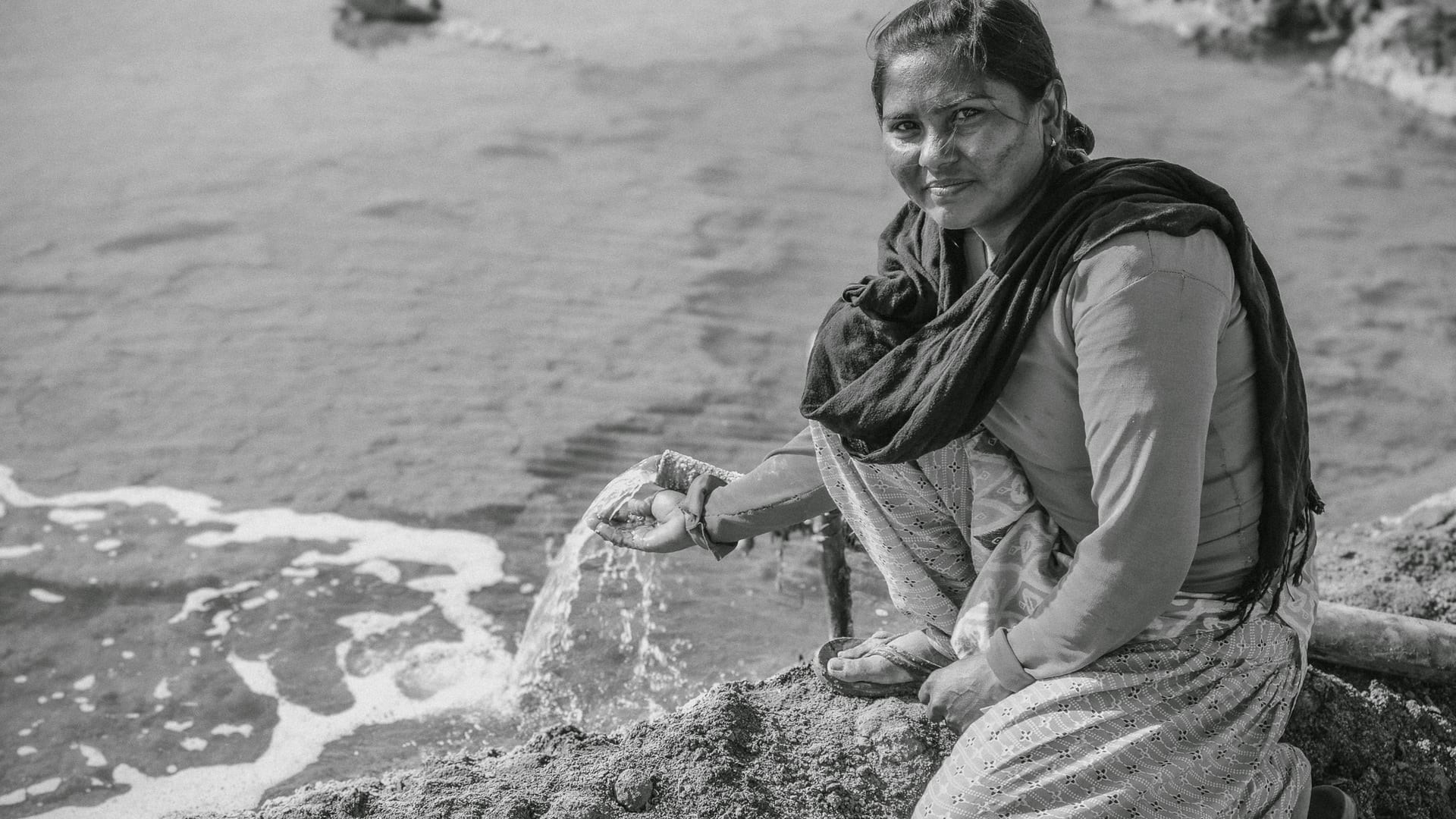
Manguben Dhirubhai Jaga, a 26-year-old salt-pan worker from Surendranagar. (Credit: Oliver Gordon / IHRB)
“Salt is everything here,” Manguben tells the JUST Stories team as she crouches beside a large rectangular earthen pan filled with evaporating brine. She scoops up a handful of large pearly white cuboids, one of nature’s wondrous geometric forms; her face wrapped in a thin scarf to protect against the unrelenting glare. “We don’t go to the office. This” – she gestures to the gleaming desert – “is our office.” The ground is parched and fissured like cracked porcelain; but in the distance, flamingos dot a flooded plain, an ominous sign for the salt farmers – despite its refreshing relief, early rain can ruin a salt harvest.
A grime-encrusted diesel-powered pump sits quietly by one of the nearby pans – a once essential cog in the process; both a blessing and a curse for the women, and a pernicious source of carbon emissions weighing heavily on India’s net zero transition. “We used to spend everything we earned on diesel and repairs,” Manguben says. “There was nothing left at the end of the season.” She recalls the engine breaking down mid-season, the belts snapping, and how they would have to wait days for a mechanic to come from the nearest town. “One year, it didn’t start for ten days. We lost so much time and income.”
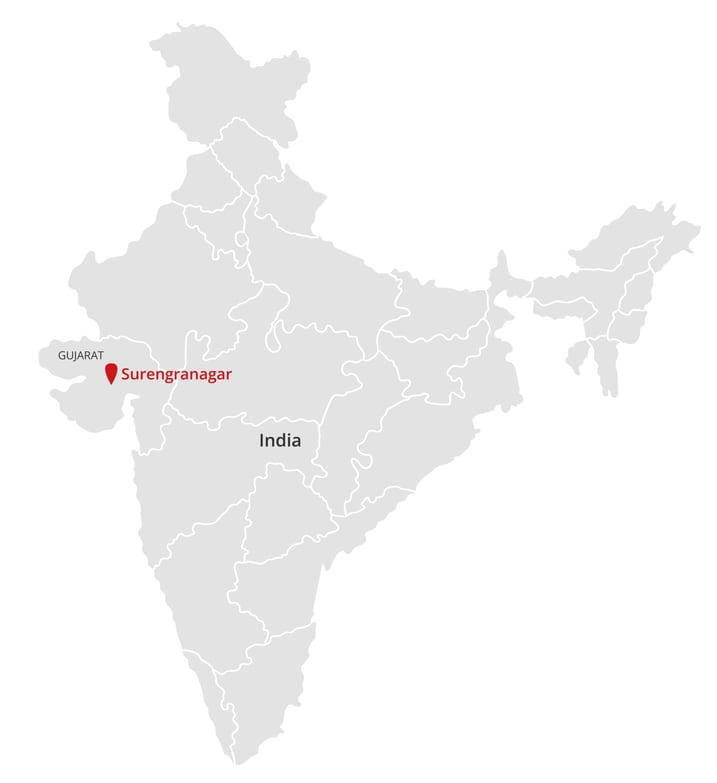
India is the world’s third largest salt producer, 80% of which comes from these inland salt flats in Gujarat. The vast majority of the workforce here are women like Manguben, but for decades they have received a pittance for their back-breaking labour; reliant on extortionate loans to buy diesel at inflated prices at the start of the season and forced to sell their salt at rock-bottom prices by exploitative middlemen.
At just 26 years old, Manguben has already spent over a decade working under the harsh conditions of the salt farms. Every year, she and her family of ten migrate 40 kilometres from their village to the desert, where they will live in a chhapara – a makeshift hut made of sticks and tarpaulin – for the next eight months. The women sleep inside and the men under the stars. Her day starts at 7am with a quick breakfast of bajri no rotlo (millet roti) and black tea. And then she’s straight into the brine: repairing lining, fixing leaks in pipes, monitoring water levels, stamping down and raking the salt in her bare feet to create the perfect size crystals. She breaks at midday to have a simple lunch of rice and dhal, before returning to the pans – only stopping when the stars start to glimmer in the sky.
There is no running water. No electricity. No shade. “We work with our feet in saltwater all day,” she says. “It burns when you have cuts. But there’s no choice – you have to keep going.” Manguben’s hands are painted white with salt, with water too precious to wash them – their supplies are only for drinking, and sparingly. After a few hours in the desert your skin starts to feel sticky and clogged, like you’ve been bathing in the sea. Manguben now travels home for a weekly shower, a luxury that she has only recently been able to afford.
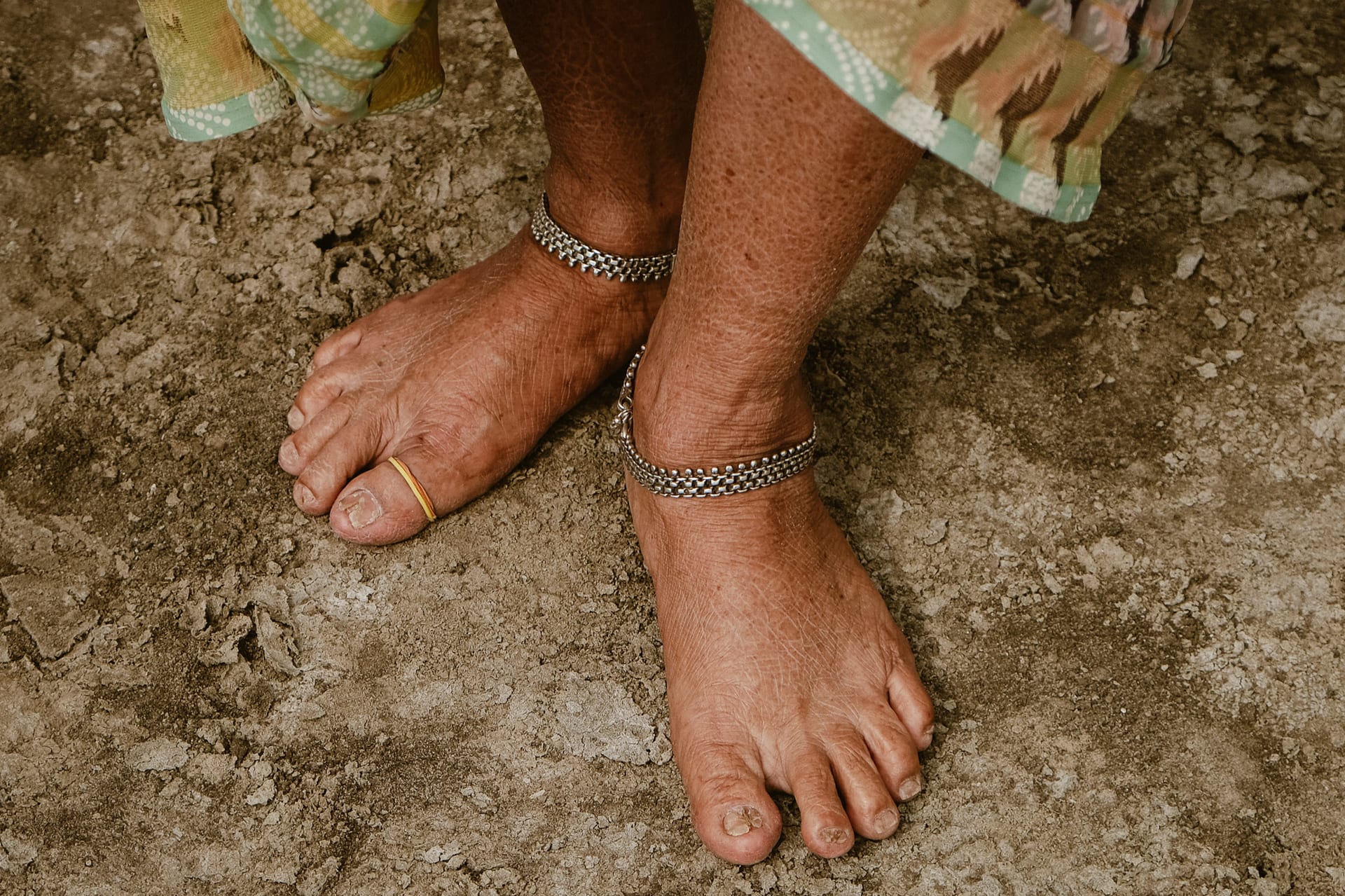
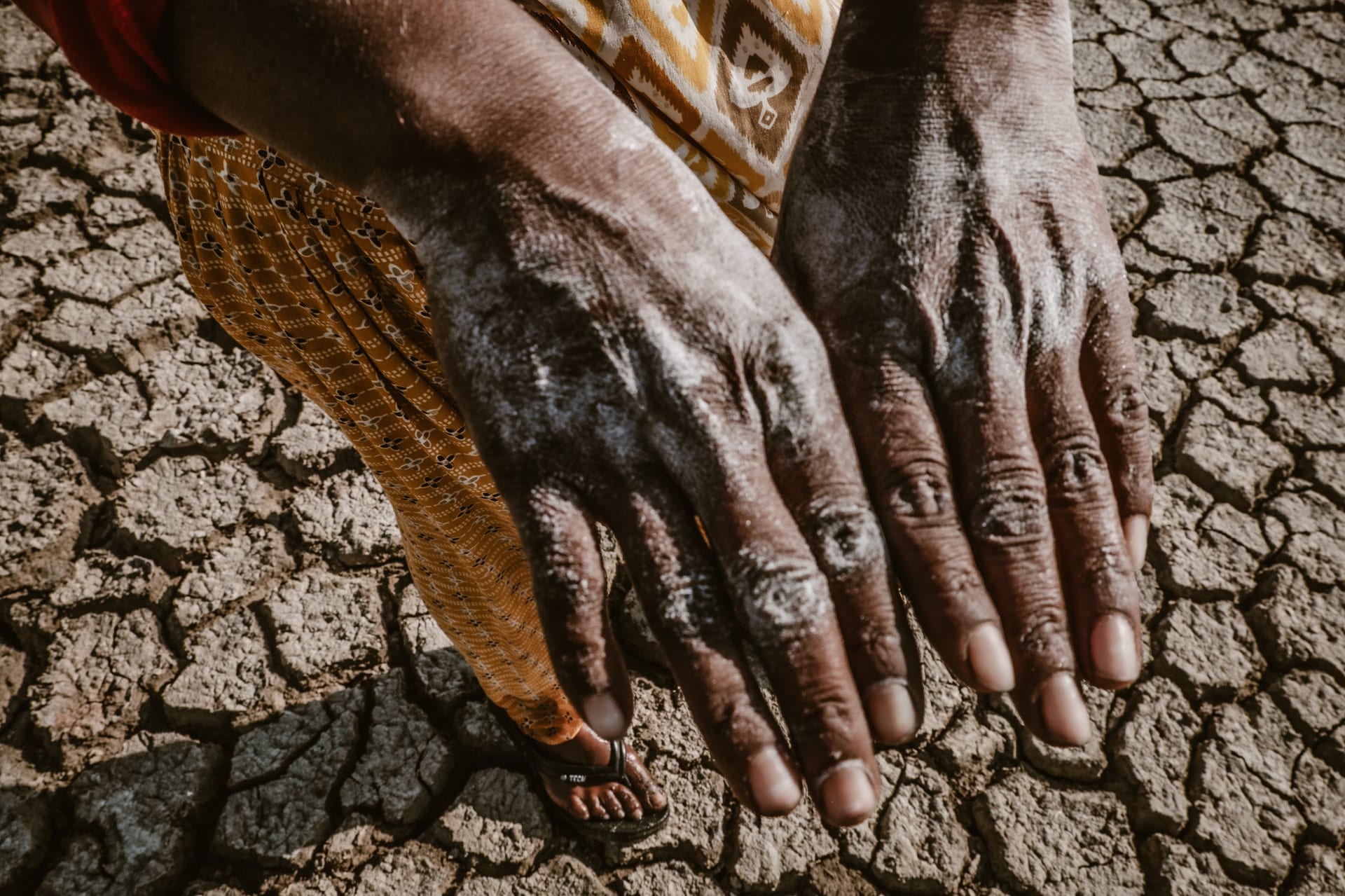
The brine takes its toll on the Agariyas’ feet and skin, but they have limited clean water with which to wash the salt off at the end of the day. (Credit: Oliver Gordon / IHRB)
But, as for most of the two billion unregistered, untaxed and unprotected workers that comprise the world’s informal economy, that’s just the way it goes – particularly for women. For Manguben however, that changed recently, when the Self-Employed Women Association (SEWA), a trade union that advocates for the rights of low-income, independently employed women across India’s informal sector, posed some simple but powerful questions: What if these Agariyas (salt-pan workers) also owned the energy that powered their salt production, and were able to maintain the technology themselves? And what if that energy was clean and healthy for both the women and the environment?


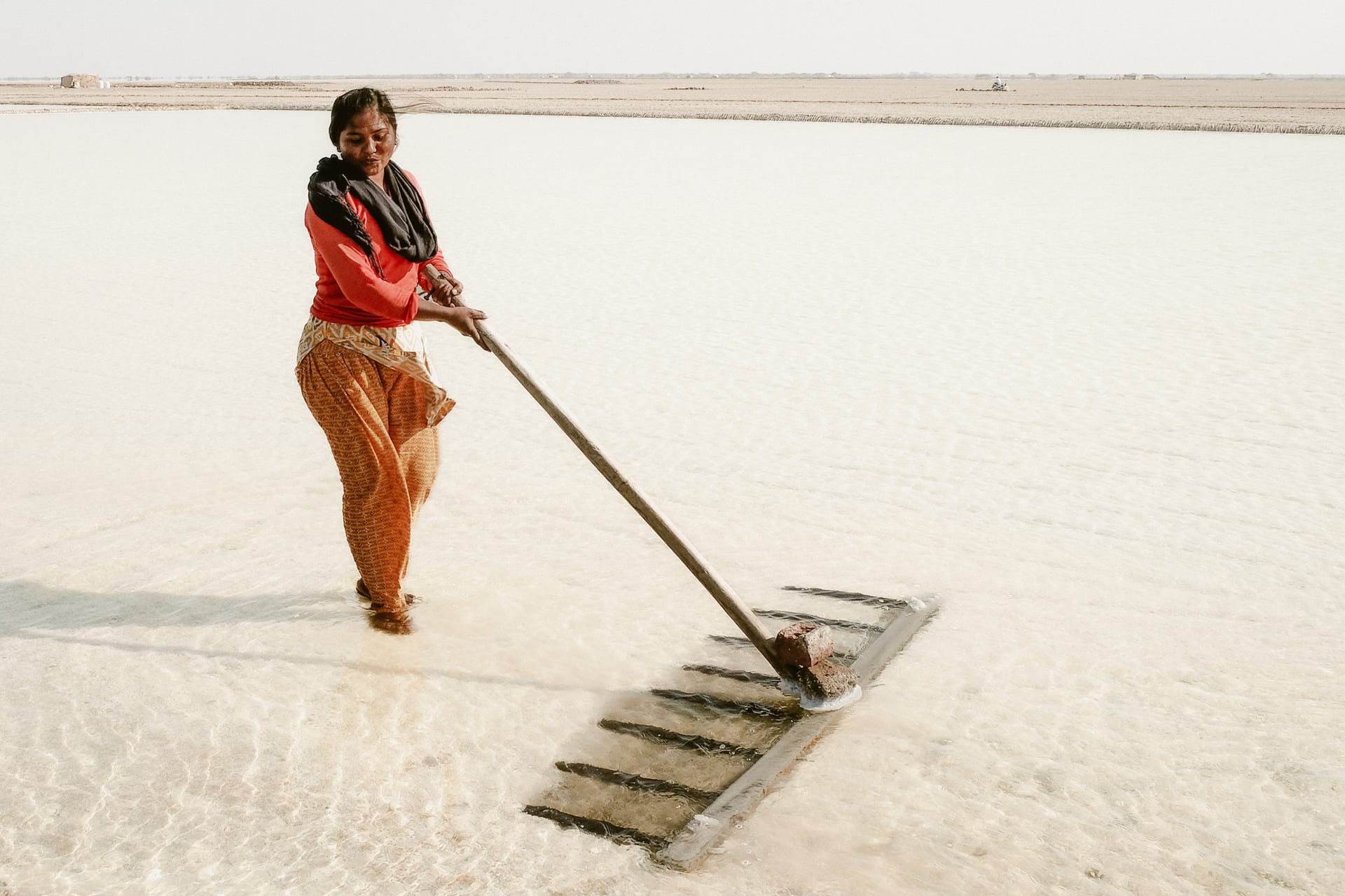

The salt farming process involves pumping brine from underground reservoirs into a series of increasingly saline pans, which are continuously raked and tamped to produce the perfect size crystals for sale. (Credit: Oliver Gordon / IHRB)
Over the past decade, with help from SEWA and its partners, the Agariyas have been steadily replacing their diesel-powered pumps with solar-powered equivalents, facilitated by comprehensive green skills training and funded through a pioneering financing scheme; thereby slashing emissions, cutting costs and giving the women control over their own economic futures. “Now, we don’t spend on diesel. We save. We decide together. ” Manguben says. “We used to feel helpless; now we feel proud.”
On the horizon, a plume of dark smoke rises endlessly from a neighbour's diesel pump. But here, two small solar panels tilt toward the sky. They make no sound. No smoke. Just consistent, reliable power from the sun.
Now, we don’t spend on diesel. We save. We decide together. We used to feel helpless; now we feel proud.
Indeed, in this barren moonscape a quiet revolution is taking place in one of the world’s most gruelling industries – one that could transform how we think about just transitions to net zero emissions, and more specifically how to realise basic human, gender and labour rights in the world’s shadow economy. With hundreds of thousands of salt pan workers worldwide – and millions of women working in informal, carbon-intensive sectors more broadly – SEWA’s business model provides a blueprint for climate action boosted by an underutilised power source: women.
“This is one of the most stunning examples of a truly just transition,” says Mary Robinson, former Irish President and UN Human Rights Commissioner, and co-founder of women-led climate justice campaign Project Dandelion, a close partner of SEWA’s, after visiting the salt pans with the JUST Stories team in February. “From bullocks to diesel to solar – owned and run by the women themselves. It’s a rare, holistic story – one the rest of the world should be learning from.”
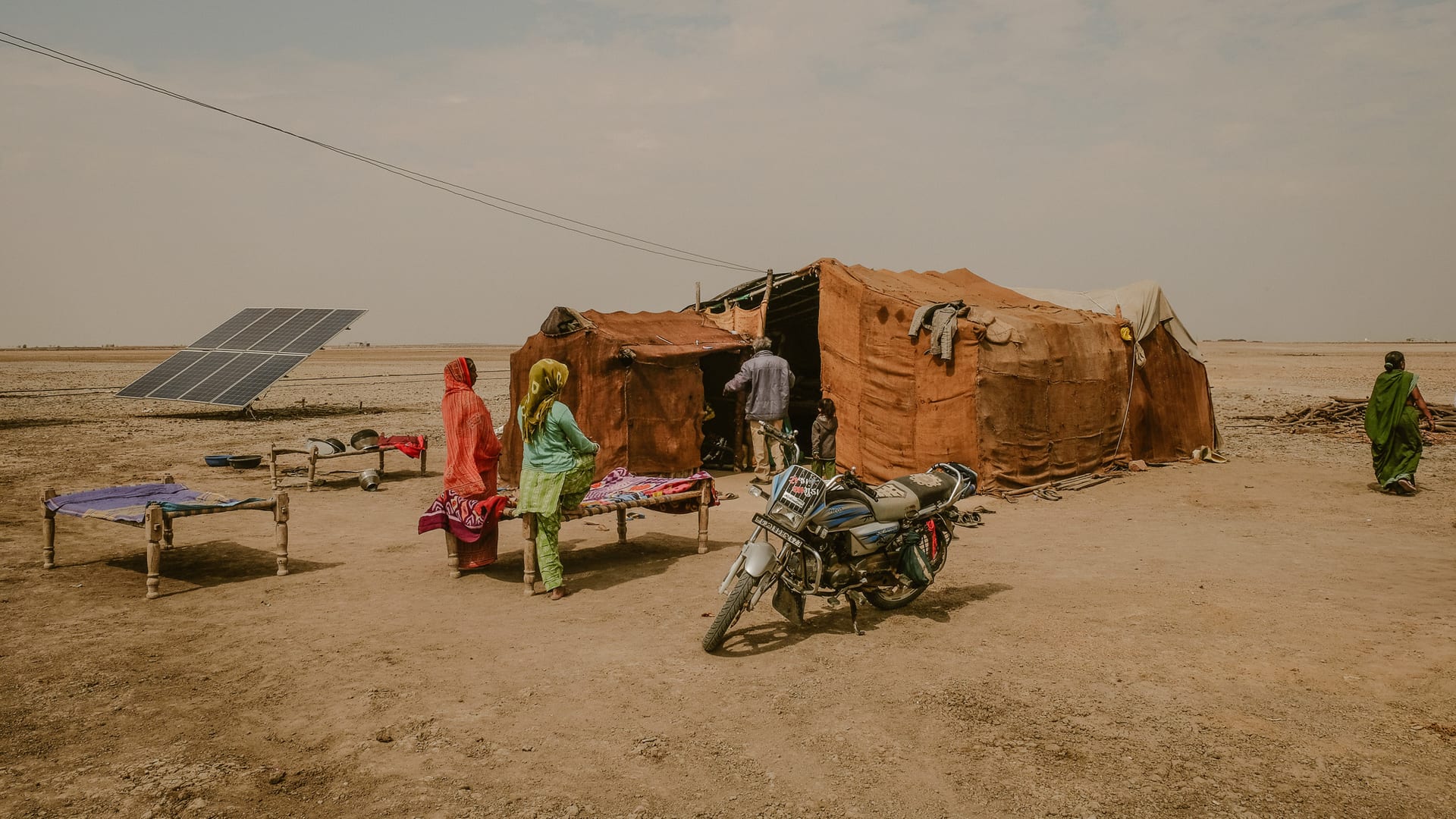
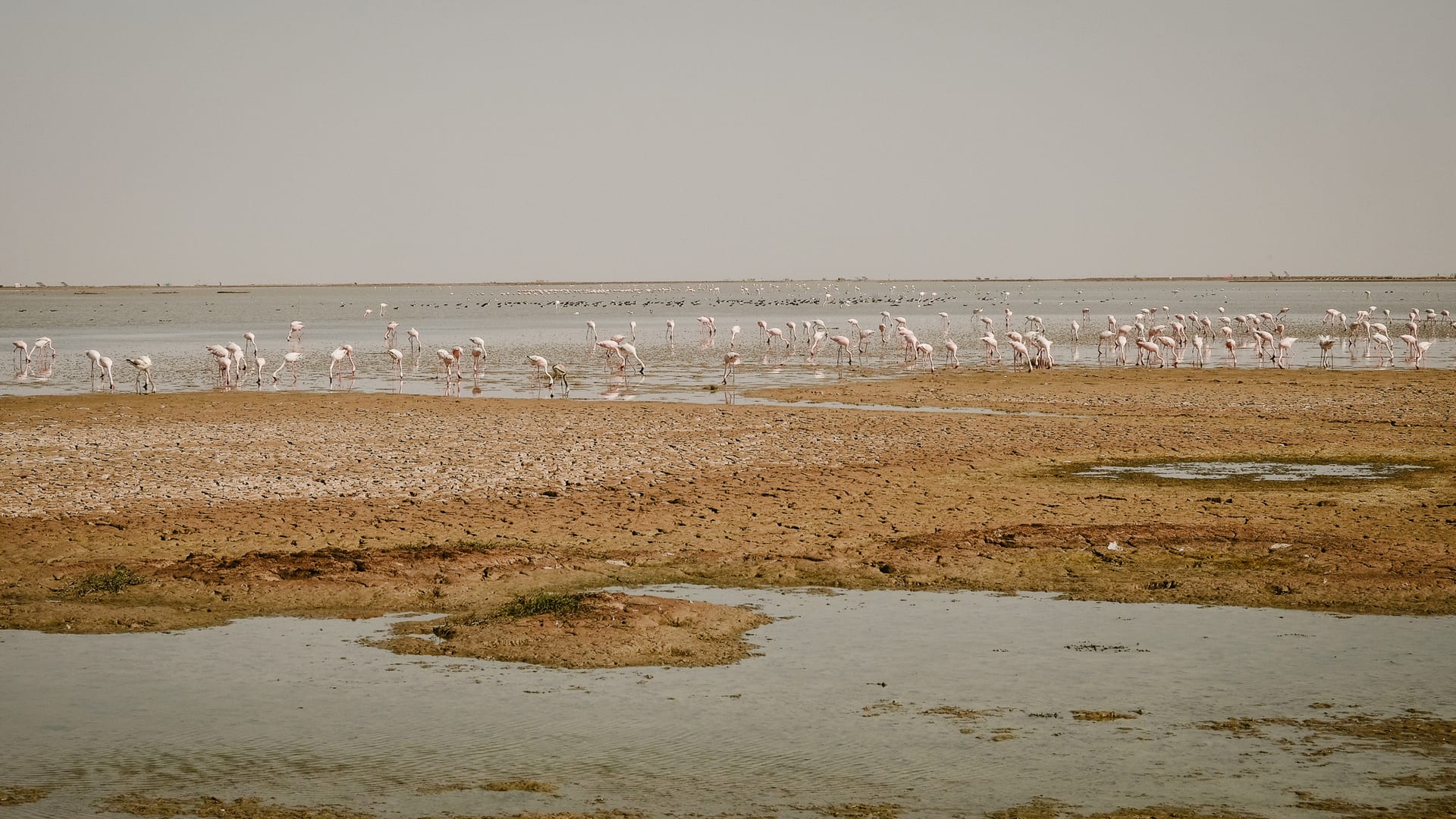
The Agariyas must live in temporary accommodation in the desert for eight months of the year. (Credit: Oliver Gordon / IHRB)
A cycle of exploitation
Salt has been integral to India’s culture and economy for millenia. “Here it is known as the ‘juice of life’,” says Reema Nanavaty, Director of SEWA. “People buy it before sunrise to ensure a good day.” And yet the country’s 30-million tonne annual salt industry is one of the world’s most extractive and unequal, shaped by generations of systemic exploitation and neglect.
The mineral is also intertwined with India’s colonial history. In 1930, Gandhi’s Salt March against the oppressive salt tax imposed by the British became an integral moment of defiance in the country’s fight for independence. “Gandhi specifically chose salt as it is a humble commodity produced by the country’s most vulnerable and impoverished workers,” says Nanavaty.
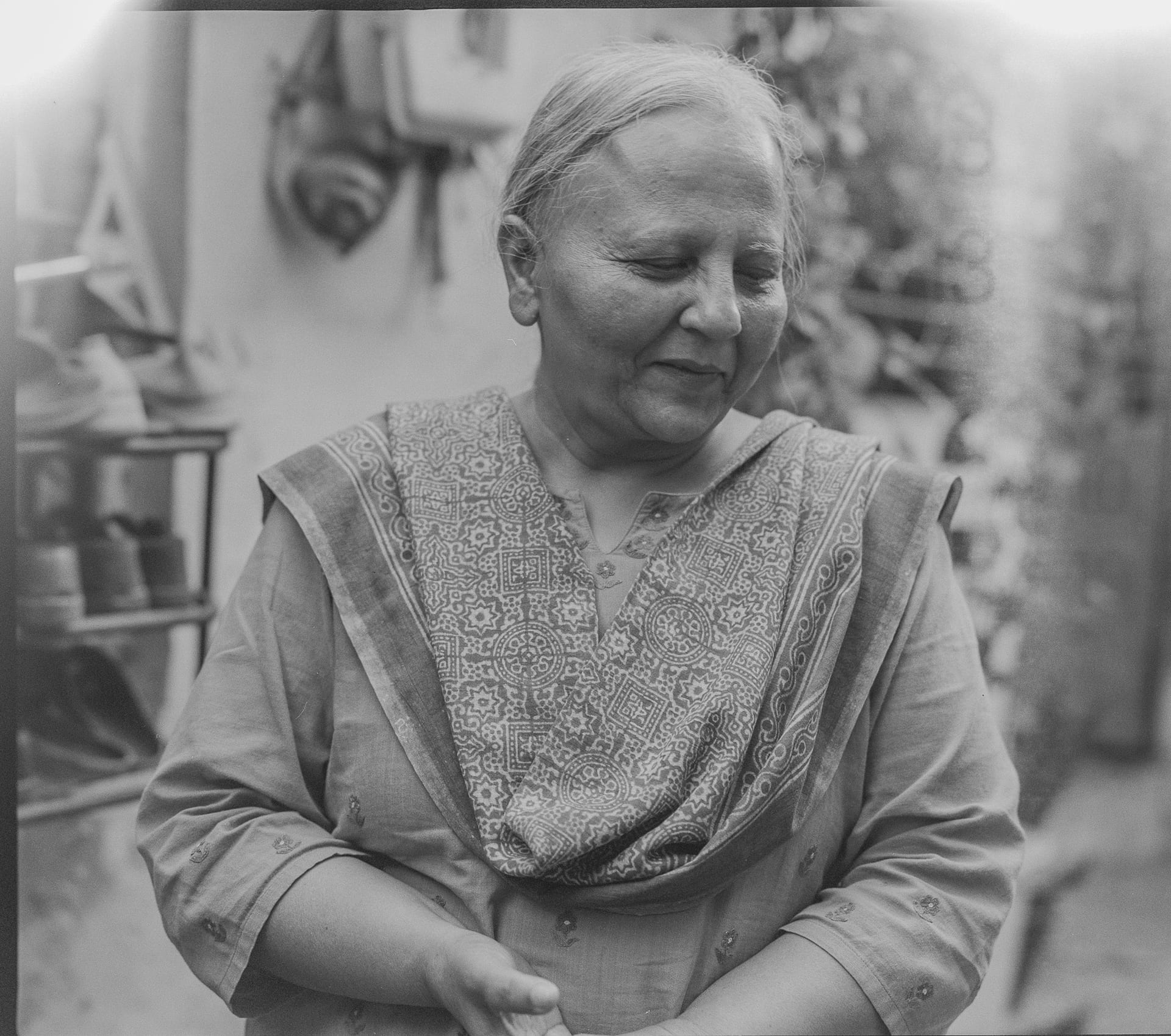
Reema Nanavaty, Director of SEWA. (Credit: Oliver Gordon / IHRB)
In Gujarat, particularly in the arid inland regions of Kutch and Banaskantha, the industry is still dominated by small-scale, informal farmers – the Agariyas – who employ the traditional technique of evaporating brine in earth-dug pans to produce salt, and have limited access to technology or finance.
Gandhi specifically chose salt as it is a humble commodity produced by the country’s most vulnerable and impoverished workers.
Every year from October to June, the Agariyas pump brine water into a series of increasingly saline pans. The desert sun crystallises it into salt, which the farmers continuously compact and rake until it forms perfectly sized crystal cubes. They then sell their harvest to local traders (primarily intermediary buyers from the Marwar region of Rajasthan), who transport it via road and rail to processing facilities. Companies like Tata Salt then wash, grind and refine the salt before packaging it for various markets. For export, the salt travels to Indian ports, crosses oceans on cargo ships, and enters another country’s distribution network through importers and wholesalers. Finally, it reaches supermarket shelves, where it is bought by consumers to equip their kitchens and dinner tables.

Historically, the Agariyas would rely on bullocks to power the pumps that extract the brine from underground reservoirs. But for the past 60 years that role has mostly been performed by diesel-powered pumps, which are both expensive and environmentally damaging. In a region already facing the pernicious impacts of climate change, the rising temperatures and extreme weather conditions these pumps contribute to only make the Agariyas’ lives harder.
An Agariya family will use around 1,300 litres of diesel to power their pumps during the eight-month farming season. In the Rann of Kutch alone, the annual diesel consumption of 56 million litres across 43,000 families is responsible for an estimated 115,000 metric tonnes of CO2 emissions. This pollution is not only a climate concern but also a health issue, with workers inhaling the toxic fumes while performing their gruelling labour, resulting in regular respiratory illnesses. “The reliance on diesel not only keeps workers financially shackled, but it perpetuates health hazards that are life-threatening,” Sameer Kwatra, India senior director at the Natural Resources Defense Council (NRDC), a key partner for SEWA’s salt programme, explains. “The environmental cost is the tip of the iceberg, it’s the invisible toll on these families that goes unnoticed.”
In order to reach the subterranean water, the Agariyas dig 30-foot narrow holes in the dry earth. They wear a rope in case they pass out from a carbon monoxide leak and have to be dragged to safety – some die each year. “It’s dangerous, but we have no choice but to keep working,” says Manguben.

Some Agariyas die every year from carbon monoxide leaks when they hand-dig wells to access subterranean salt-water reservoirs. (Credit: Oliver Gordon / IHRB)
Although salt farming is a family business for the Agariyas, the cultural norm is for the women to do the most laborious and back-breaking of the salt-farming work, and for men to deal with the business and finances. As such, these women are often excluded from the decision-making processes that impact their lives, from wage-setting to financial and energy independence. They are often forced to rely on male intermediaries to purchase diesel, negotiate with traders and even manage household finances, perpetuating gender inequities. The women are typically the last to be paid for their salt.

Lacking the labour protections of a formal sector, most Agariyas must take out working capital loans from the traders at the start of a season to pay upfront for the diesel for their pumps. This gives the traders control over the flow of capital, and a poor season can often result in an Agariya family becoming trapped in a vicious cycle of debt; akin to a form of debt bondage. “The system is rigged,” says Heenaben Dave, Vice President of SEWA. “The women have no say over pricing or when they get paid. They work hard, but their earnings are constantly at the mercy of traders who have all the power.”
Staring forlornly at the heat-undulating horizon, Manguben recounts: “I would work under the scorching sun, day after day, but most of the money would go to the traders. I was lucky if I got paid on time.”
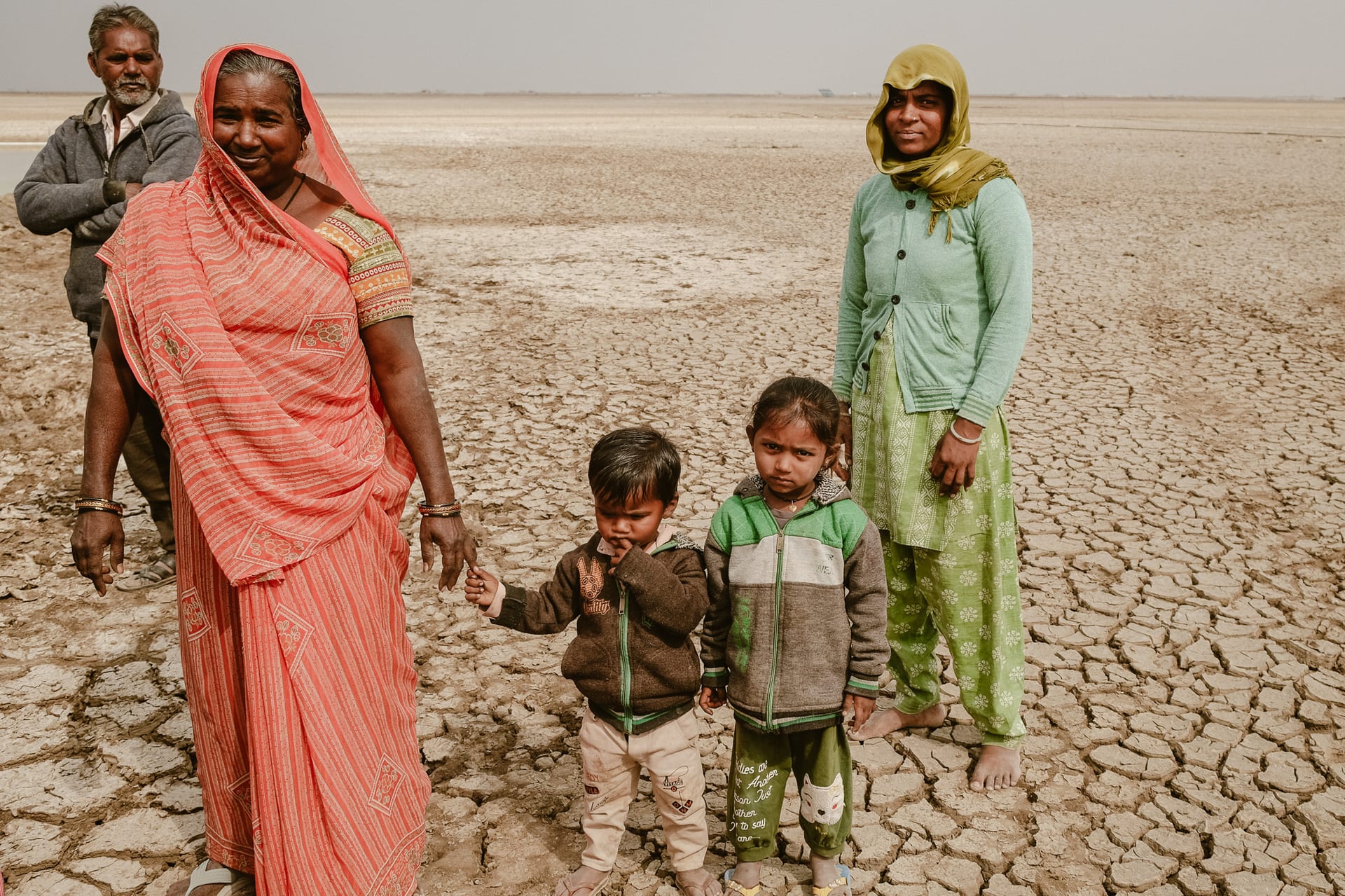
An Agariya family in Surendranagar. (Credit: Oliver Gordon / IHRB)
In real terms, Agariya families pay 40-60% of their annual income on diesel and only earn around ₹150 ($2) for each ton of salt – while the market price is over ₹17,000 ($239). The traders – who hold a quasi-monopoly on the rail wagons that transport the salt around the country – take the lion's share. “It’s a vicious cycle,” says Kwatra. “Once they fall into debt, it becomes impossible to break free. The traders hold all the leverage, and the workers, particularly the women, are left with very little choice but to continue working under these conditions.”
This is compounded by the seasonality of the industry, with the women having to disrupt their families and communities by migrating to find work in the four-month off-season. Often they have to take on new loans to get by, further entrenching their indebtedness. “During the off-season, my family would struggle to find enough work,” recalls Manguben. “We would rely on loans from traders, and if the season was bad, we couldn’t pay them back. It was a never-ending cycle.”
After understanding the multi-faceted plights of these women, SEWA realised that any climate solution had to also incorporate the social and economic issues as well. “It’s not just about reducing diesel use; it’s about empowering women to take control of their work and their lives," says Nanavaty.
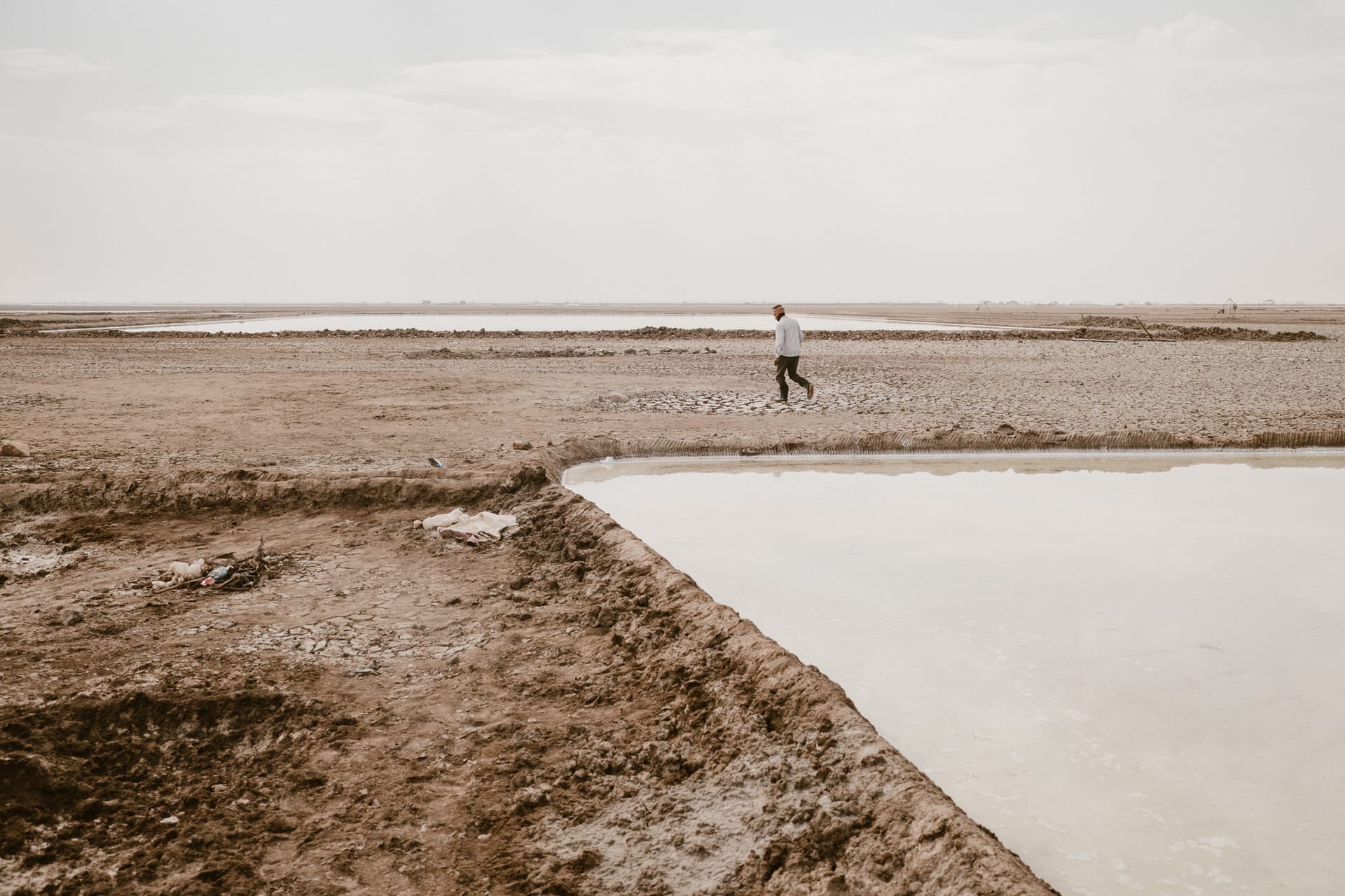

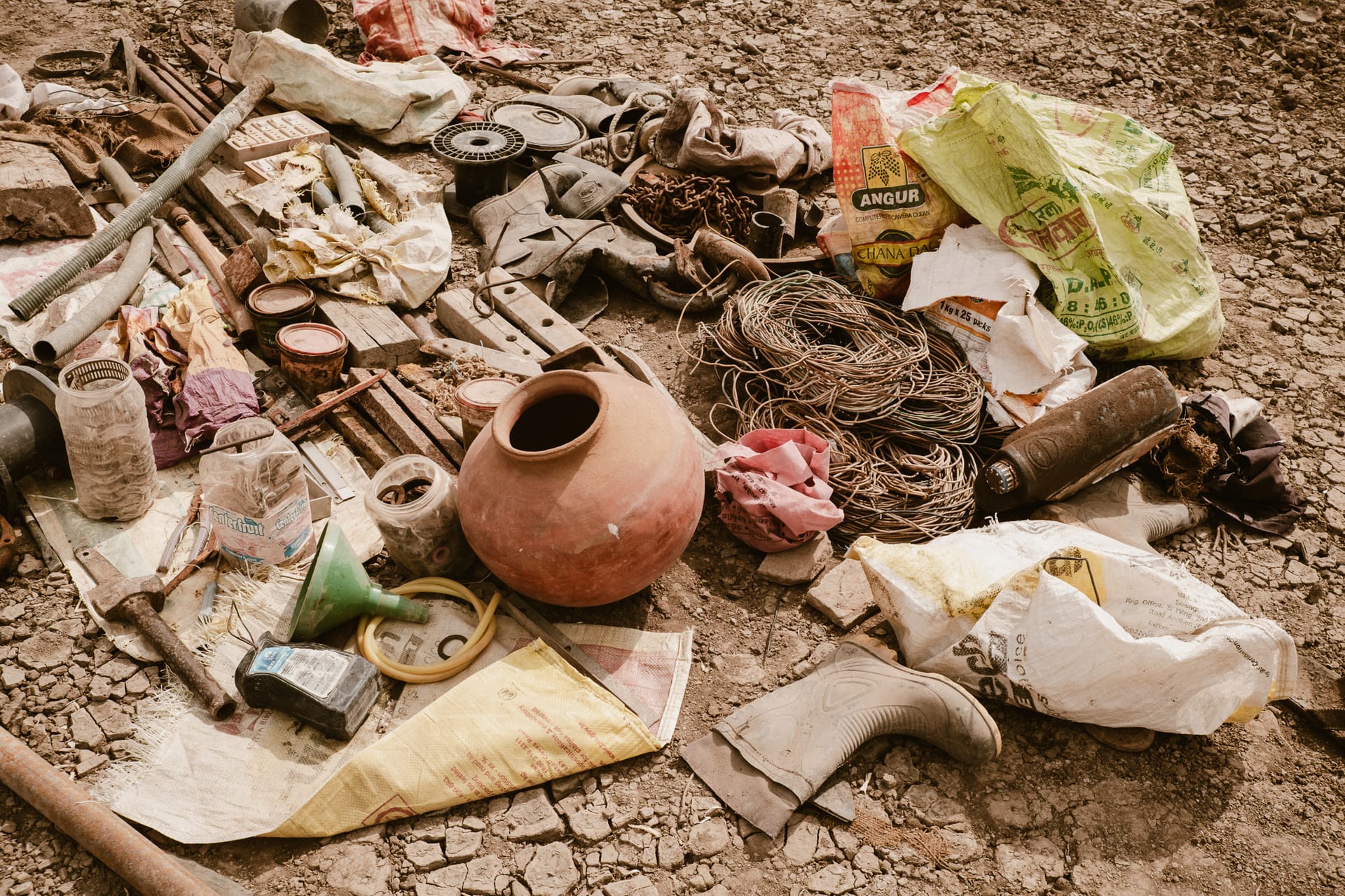
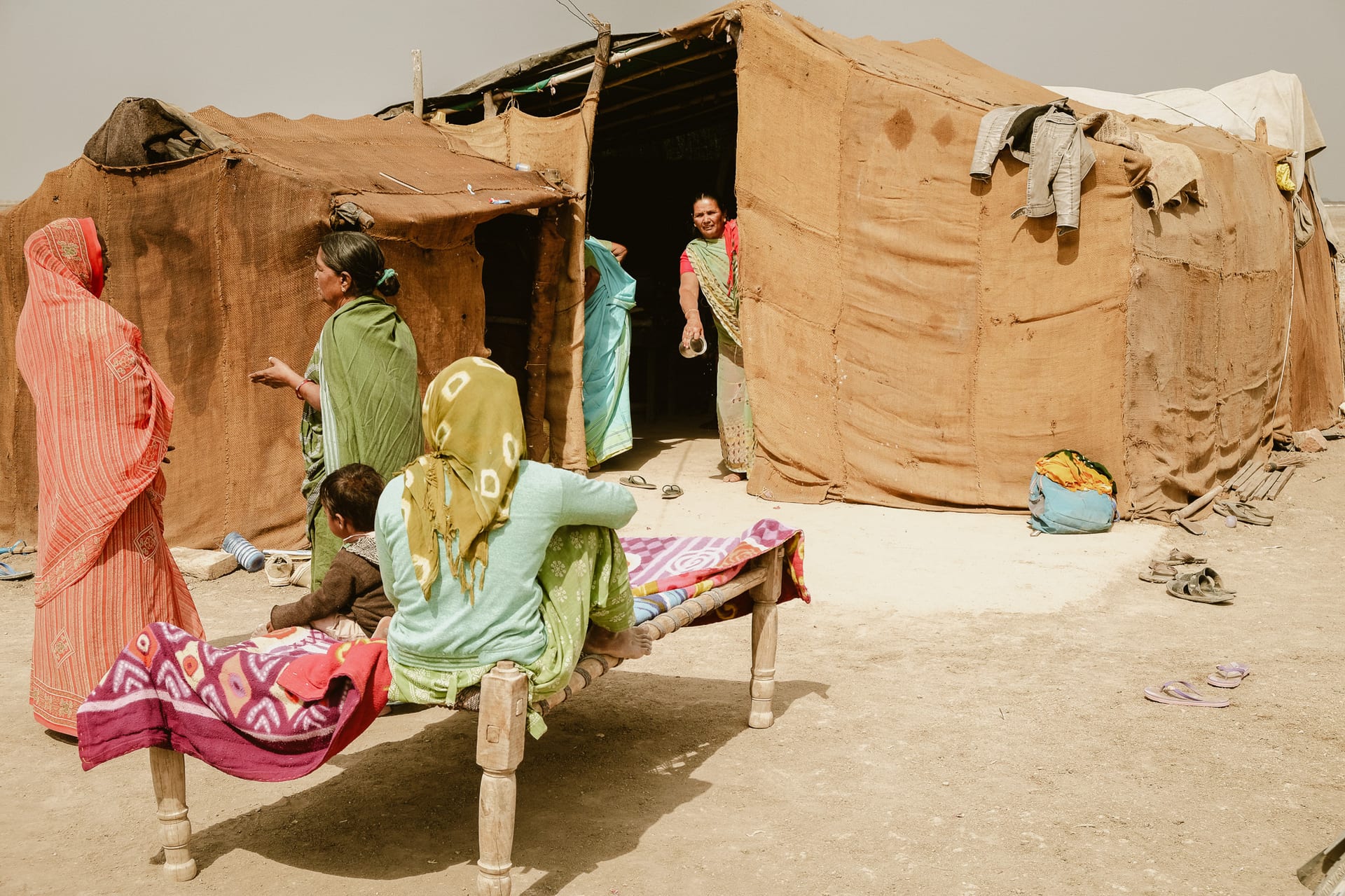
The Agariyas must endure some of the world’s toughest working conditions, with temperatures often reaching 45ªC. (Credit: Oliver Gordon / IHRB)
Women taking power
Founded in 1972 by the late Ela Bhatt, a renowned Indian lawyer and social activist, SEWA has long been a leading force for gender equity in India, today boasting 3.2 million members across the country. Originally focused on cities, the union began to spread out to rural areas in the late 1980s. “The textile artisans would always disappear around October, and then we eventually realised they would be going to the salt pans,” said Nanavaty. “So we spent a month living in the desert with them to understand their issues, and realised they were essentially in bonded labour. In fact, the traders would try to sabotage us, by slashing our tires and so on, so that we couldn’t help the women.”
They officially started working with the Agariyas in 2010, providing them with healthcare and childcare support, but soon realised that more fundamental changes were needed. After a year of consultation with the women, SEWA identified the solar-pump transition as the most impactful course of action. “We didn’t impose a solution on the women,” Dave explains. “We were listening, not just providing. We asked the women what they needed, and they identified solar pumps as the best solution.”
To test the technical feasibility, SEWA launched a pilot in 2013 with 14 solar pumps for 14 Agariya women. The Agariyas were given zero-interest loans through SEWA’s district-level association. The participating women – two using solar-only systems and 14 using hybrid solar-diesel systems – recorded major cost reductions. SEWA also helped the women organise producer cooperatives (businesses where producers pool their output for their common benefit) to bargain for better prices with salt traders and factories.
We were listening, not just providing.
SEWA then partnered NRDC in 2014 to build a business case to bring solar pumps to all the Agariya families. With support from US-based renewable energy company SunEdison, they distributed 200 solar-powered water pumps to Agariyas in the Little Rann of Kutch. The resulting economic, social, environmental and commercial benefits witnessed by the participants served to kickstart the expansion of the programme.
Based on the usage of the salt farmers, SEWA and NRDC developed – with help from engineers from the Massachusetts Institute of Technology – technical specifications for efficient solar pumps for the desert, such as the size of electric motors and solar panels required. They also worked with the Ministry of New and Renewable Energy (MNRE) to better incorporate these specifications in its capital subsidy scheme, which was intended for larger capacity irrigation pumps. Next, the partners engaged with National Bank for Agriculture and Rural Development (NABARD), the government agency implementing the subsidy, to ensure it reached the farmers. In addition, the Government of Gujarat announced 80% subsidies on solar pumps for salt farming in 2017. These incentives helped reduce the salt farmers’ upfront costs to purchase the pumps.

SEWA’s Heenaben Dave (far left) with some Agariya women she works with in Surendranagar. (Credit: Oliver Gordon / IHRB)
However, the Agariyas still required loans to purchase the pumps: at $2,000-$2,500 each, the pumps were still out of reach for the Agariyas’ meagre $100/month salaries. Micro-businesses typically face challenges in obtaining loans for equipment and technological investments due to risk perceptions of traditional lenders. So SEWA and NRDC worked with the women to explore ways to attract more public and private finance.
Discussions with leading financiers such as the International Finance Corporation (IFC) highlighted the opportunity for sustainable finance for clean energy, addressing common barriers to financial access such as lack of identification and address documents, insufficient awareness amongst the women about formal banking requirements, and lack of access to loans due to the seasonal nature of the Agariyas’ income. The partners eventually identified three successful financing measures to reduce the cost and corresponding loan amount for the women: vendor financing, capital subsidies and low-cost loans.
SEWA loaned the solar pumps to its members on five-year, zero-interest installment plans; with SunEdison providing the pumps to SEWA at zero-cost vendor financing. To avoid burdening the farmers, the installments were seasonal – payable during the salt-production season. These loans were affordable because of the money the farmers saved on diesel, which effectively meant that the pumps paid for themselves by the end of the period. With a 12% interest rate, the payback period for the women switching to hybrid pumps was as low as 38 months.
The salt farmers’ successful repayment record in the early stages demonstrated the economic viability of the solar-pump financing. In the subsequent phases, SEWA Bank’s Grassroot Trading Network for Women (GTNfW), facilitated the financing. (SEWA Bank itself was set up in 1974 as a cooperative bank aimed at providing credit to SEWA members to empower them financially and reduce their dependence on money sharks.)
But to attract more commercial banks to the scheme, IFC created a blended finance mechanism (using public sources of capital to attract private investment) to de-risk the credit. The IFC used philanthropic funds provided by India’s YES Bank to create a ‘first loss guarantee’ for the lenders which would cover the first 25% of losses in the case of defaults. “With the first loss guarantee, we were able to provide a risk mitigation solution that reassured the lenders,” says Arun Sharma, the then chief investment officer at the IFC, who led the structuring. “With risk of losses due to borrower defaults significantly reduced, SEWA Bank could then make loans in amounts way over their normal credit limit (banks have limits on how much they can lend to specific customer segments) to finance the solar pump purchases by the Agariyas.”
This mechanism helped SEWA Bank finance another 600 solar pumps in 2017, and convinced Bank of Baroda (BoB), India’s third largest public sector bank, to extend loans at reasonable rates to the Agariyas. BoB and SEWA signed a memorandum of understanding (MoU) where BoB committed to extending direct loans for 15,000 more solar pumps, enabling a massive expansion of the project.
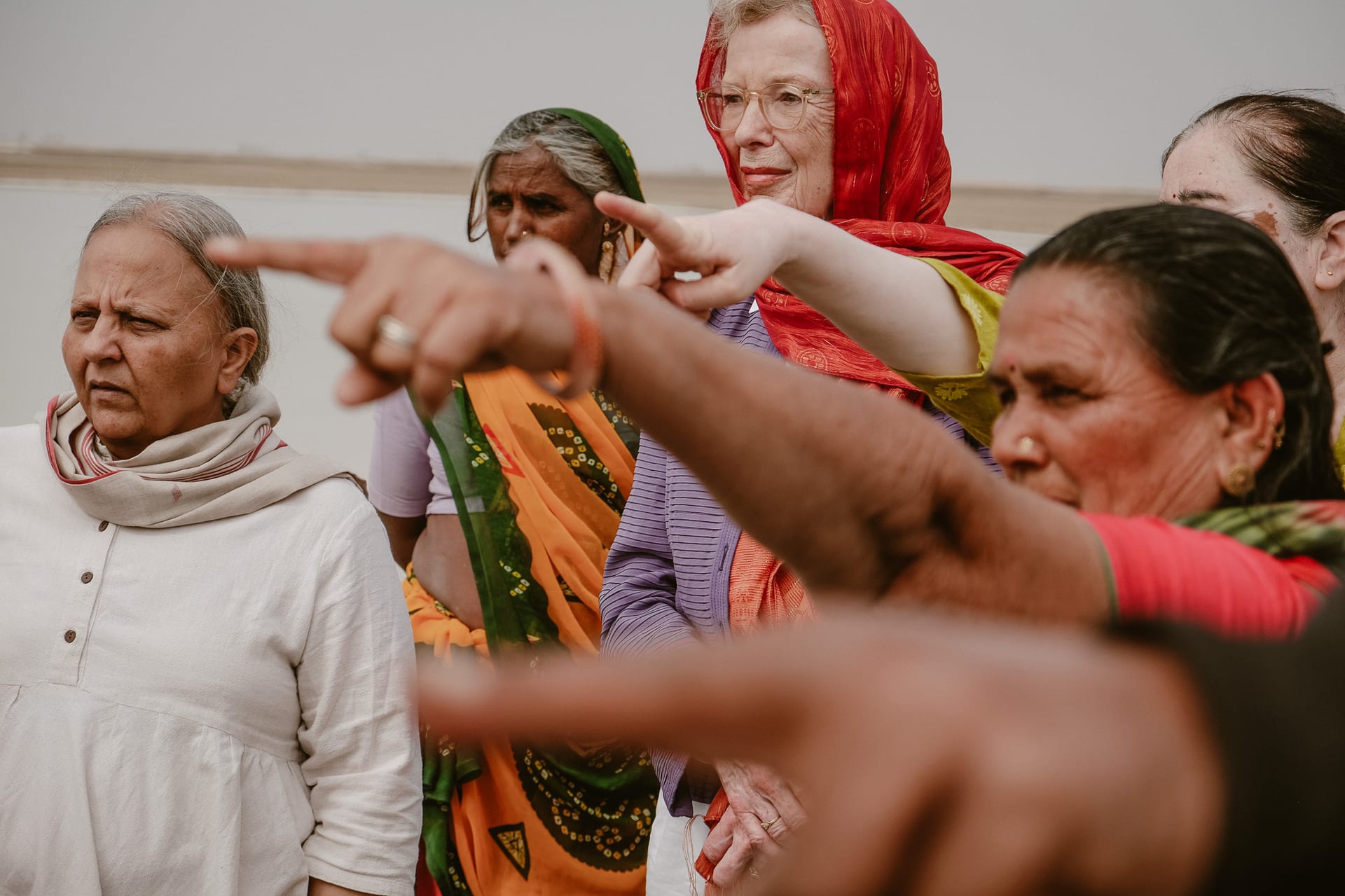
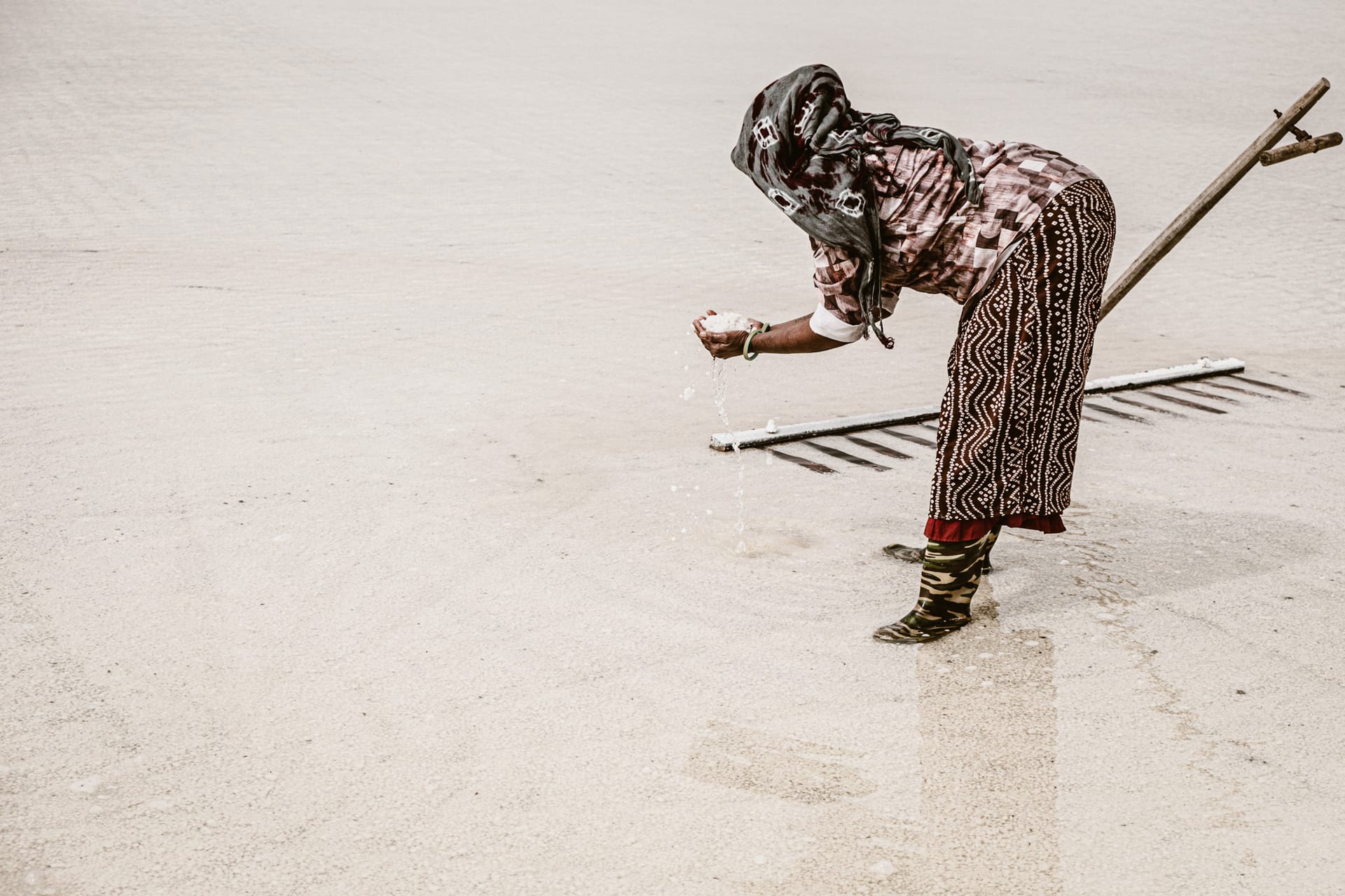
Reema Nanavaty and Mary Robinson are shown the salt farming process by Agariya women in Surendranagar. (Credit: Oliver Gordon / IHRB)
SEWA also realised that because of the emissions reductions deriving from replacing the diesel with solar power, the programme was eligible for carbon credits – tradable certificates that can be bought and sold to offset emissions, either through projects that prevent emissions or projects that remove existing greenhouse gases.
After three years in the making, a carbon credit scheme came online on the Gold Standard trading platform in 2018, with the proceeds helping pay off the women’s loans for the solar pumps. “The carbon credits were a game-changer,” says Atul Bagai, UNEP’s then country manager for India, another key partner on the programme. “They provided an additional stream of income, which helped us maintain the financial sustainability of the programme.”
But eventually SEWA realised it was at risk of repeating one of the mistakes of the past; where the women were reliant on male engineers or outside experts to install the diesel pumps or fix them when they regularly broke down. To solve this, in 2019, SEWA – with the help of UNEP and India's Skill Council for Green Jobs – set up a programme to train the women themselves as solar engineers, able to install and maintain their own solar panels and pumps and – importantly – others’ solar infrastructure too. “It was quite a surreal sight watching Reema and UNEP’s chief sign an MoU in the middle of the desert surrounded by thousands of women,” recalls Bagai. “There was huge market demand in India for solar engineers and we realised that we could also answer that need with this project. It was a win-win situation: the women gained financial independence, and the renewable energy sector gained a skilled workforce to support its expansion.”
There was huge market demand in India for solar engineers and we realised that we could also answer that need with this project.
After some initial success, UNEP decided the training could be better handled by a local renewable energy company and went in search of a possible private-sector partner. With a strong business presence in Gujarat, ReNew fitted the bill perfectly. The company joined the project and launched its ‘Project Surya’ training programme in 2022, with the aim of training 1,000 Agrariya women as solar technicians. The project was anchored by ReNew Foundation, which was established following India's 2014 legislation mandating companies to allocate 2% of profits on corporate social responsibility (CSR), but the company knew that the work made sense from a business perspective too. “ReNew never promised jobs, but we knew there was a significant demand for skills in the sector and so a gap which needed urgent attention,” says Vaishali Nigam Sinha, Co-founder of ReNew and Chair of the ReNew Foundation. “With solar and wind facilities across India, finding skilled talent locally remains a challenge we are determined to solve, by ensuring women get trained and are at the forefront to fill this gap.”
Manguben completed the training in 2019 and now is a registered solar technician. She is in charge of the family’s solar pump system, and is able to fix it when it breaks. In the off-season, she earns a living installing solar infrastructure in other villages. “Before, I never imagined that I could be a technician; the salt pans were my entire life,” she says. “It’s a huge change for me.”
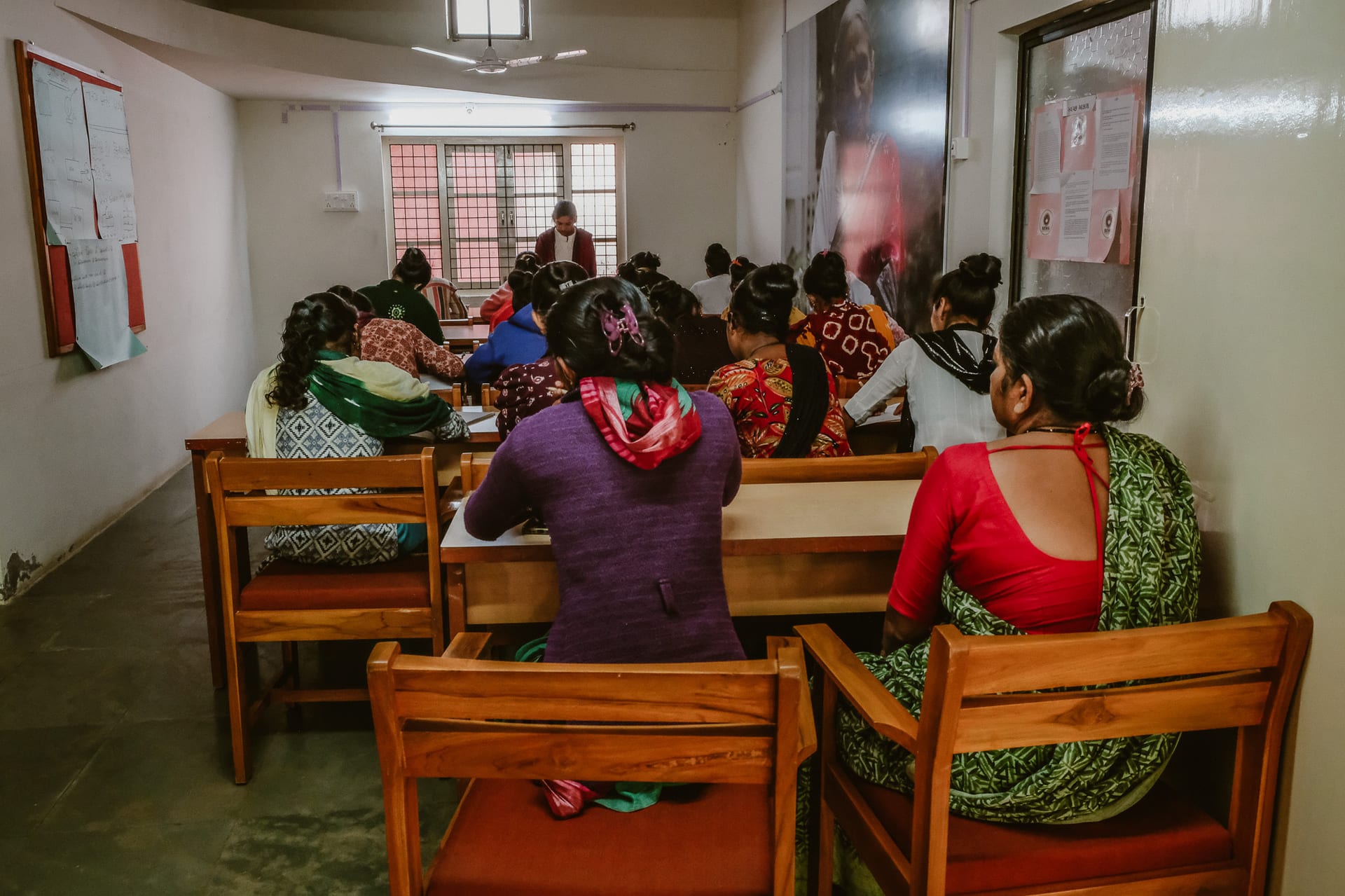
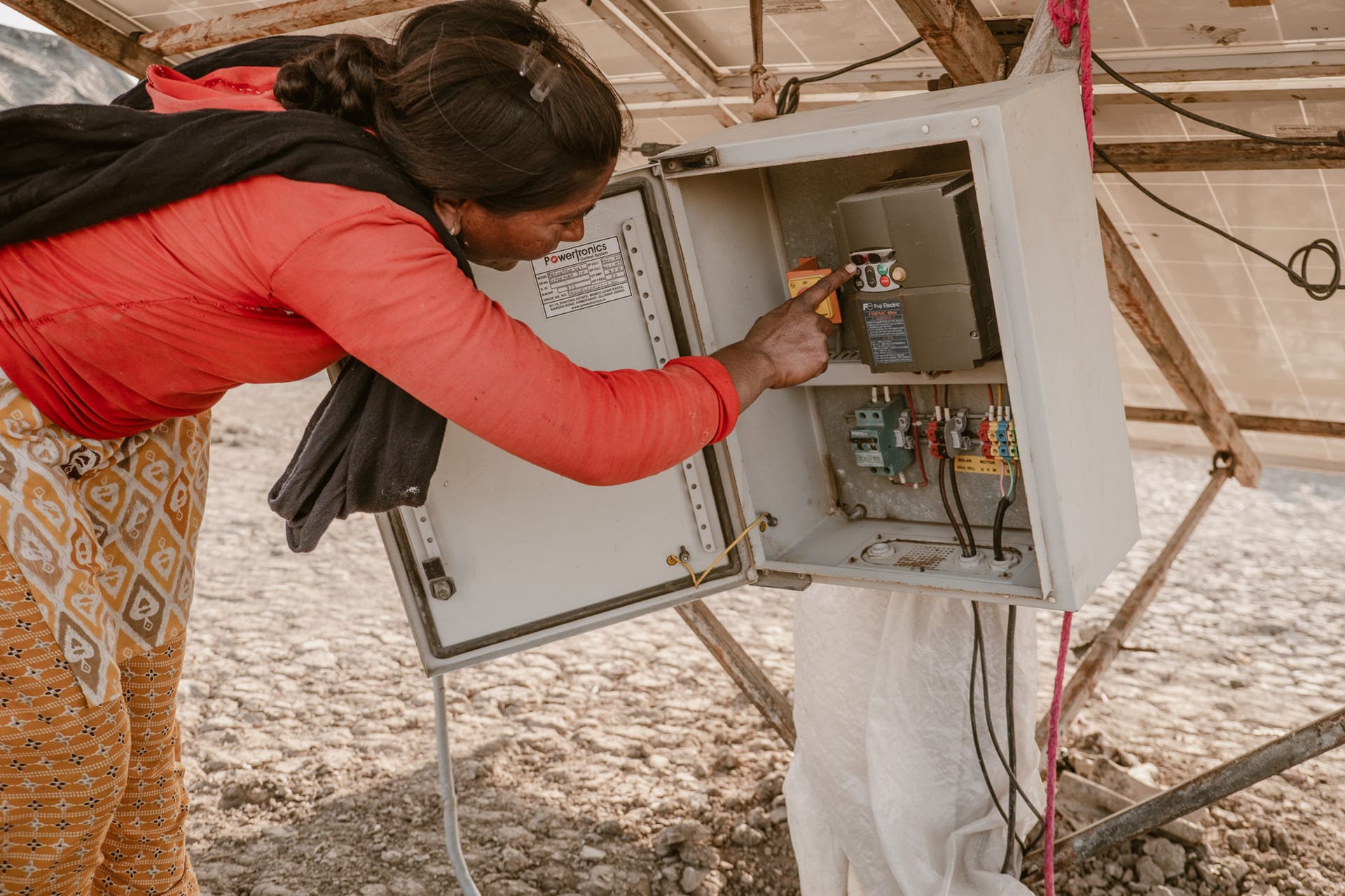
The solar technician training programmes are designed to be hands-on and accessible, allowing workers to build their technical capacity from the ground up. (Credit: Oliver Gordon / IHRB)
And the programme’s evolution didn’t stop there. SEWA realised that the off-season served as an opportunity to turn the women into ‘energy entrepreneurs’. “We wanted the women to own the whole value chain of the solar energy,” explains Nanavaty. They devised the idea of a temporary solar park at the edge of the desert, where the women could transport and install their individual solar panels at the end of the season. This seasonal solar park would then generate electricity to sell to the grid during the off-season, until the solar panels were needed back in the desert the following season.
“Now, the solar panels don’t sit idle during the off-season,” explains Dave. “The women pool their panels into a collective solar park, and they sell electricity to the grid, creating a new, passive income stream that isn’t reliant on the salt pans.”
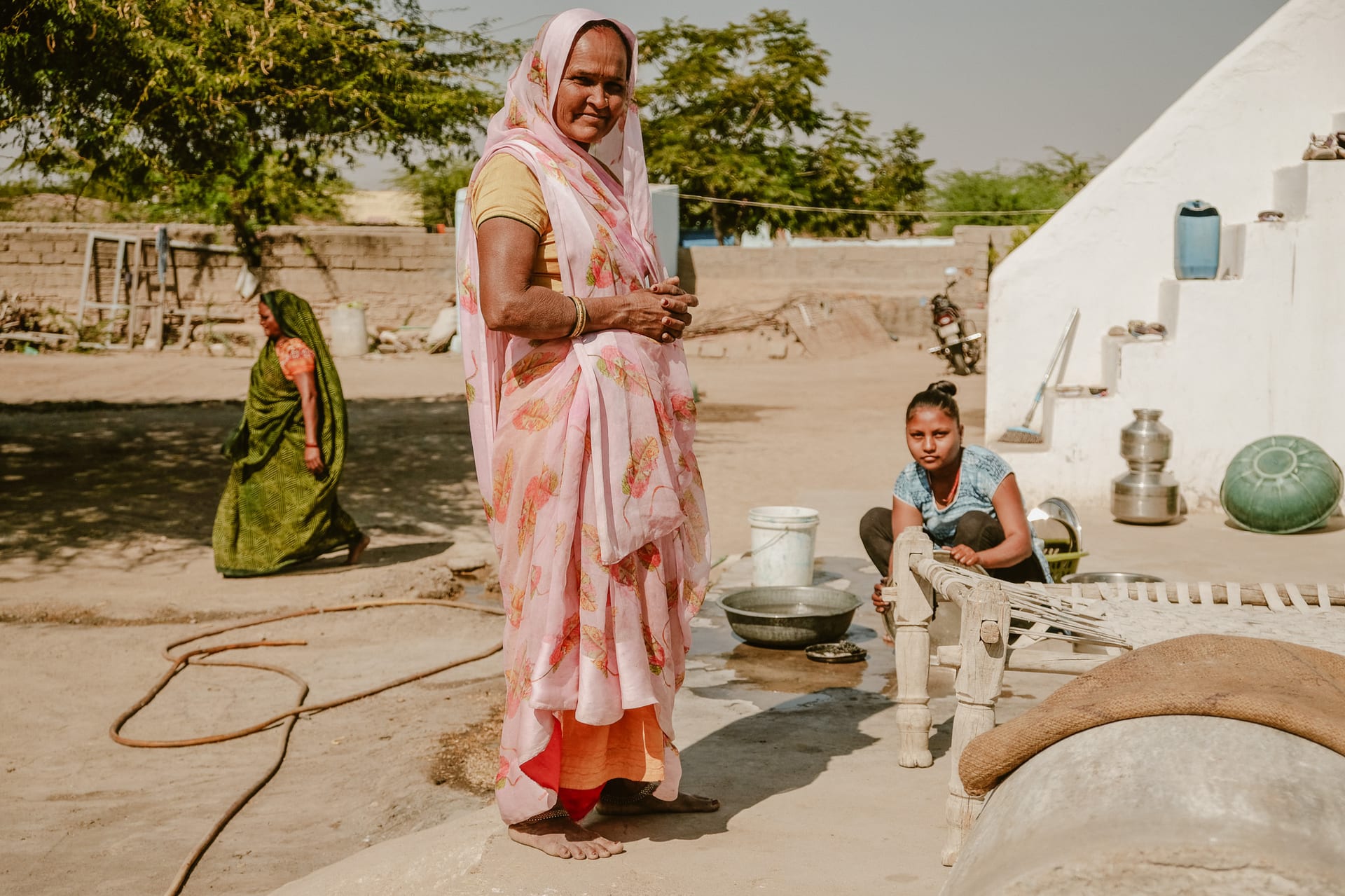
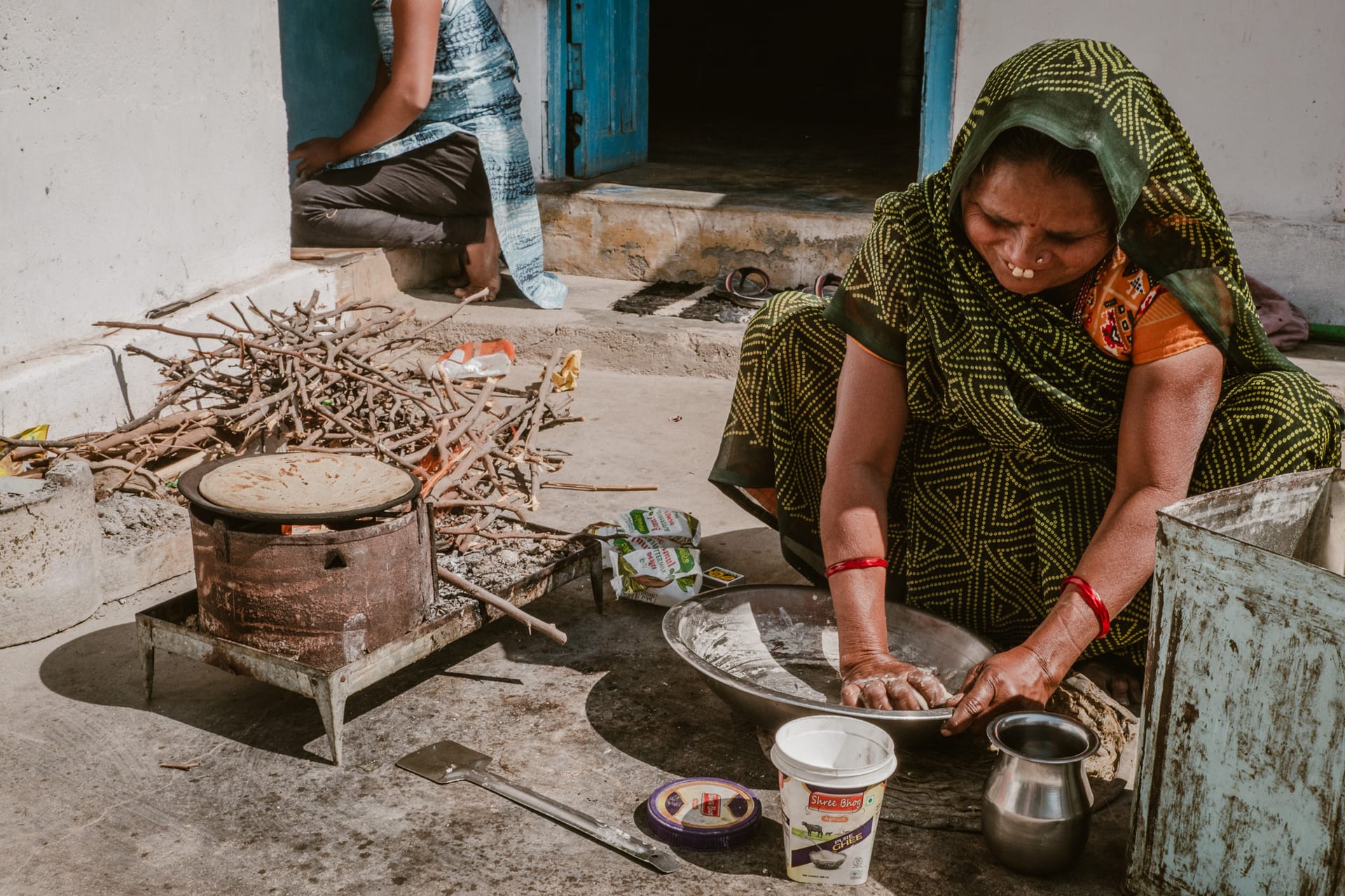
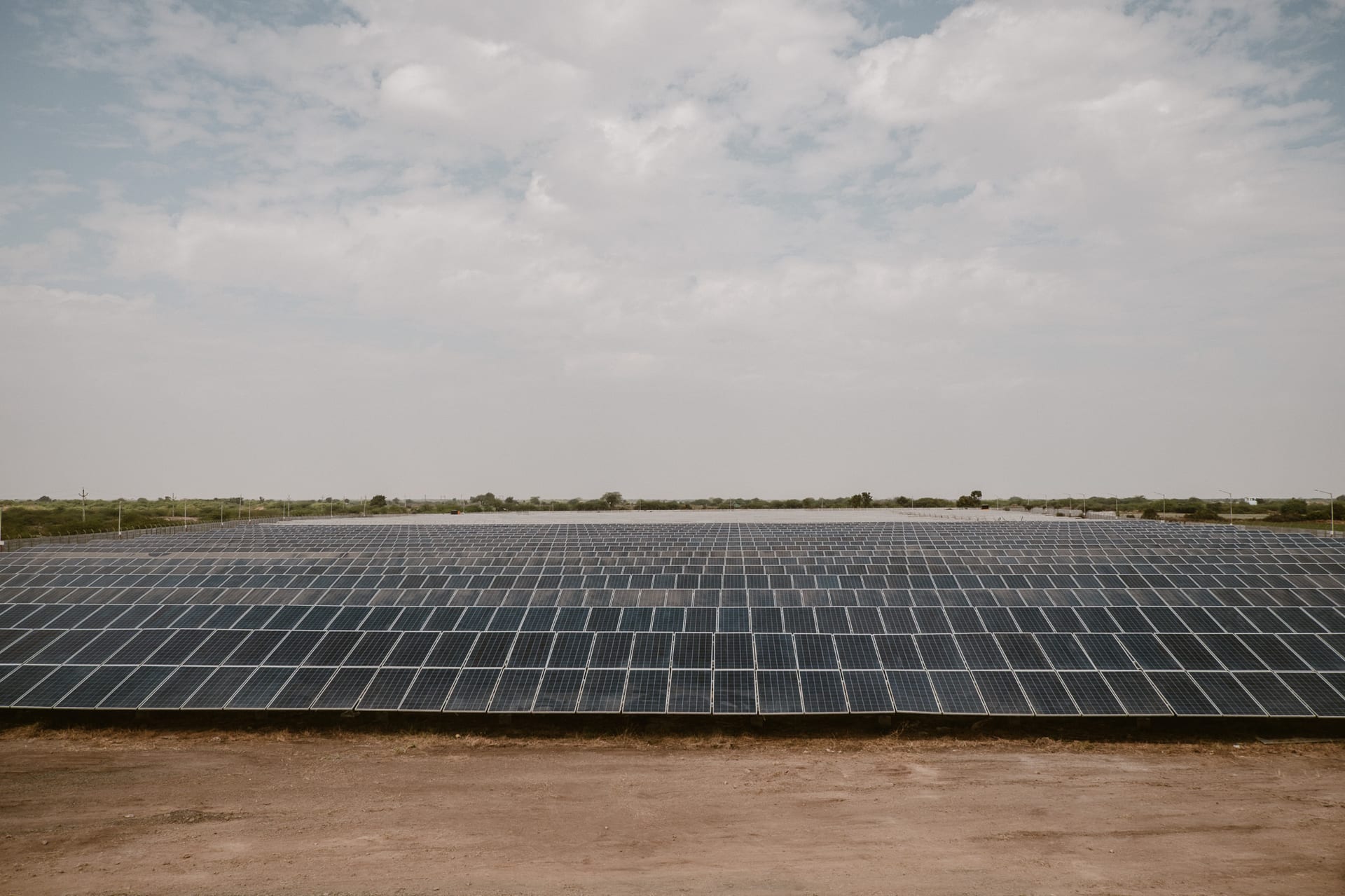
The temporary solar park is designed to give the Agariyas a source of passive income when they return to their villages after the salt-harvesting season. (Credit: Oliver Gordon / IHRB)
The SEWA model: ‘An exercise in collective will’
And after years of iterative development, the comprehensive model that has emerged – based on cooperative ownership, training and collective empowerment – is already bearing fruit. So far, there have been 7,000 solar-powered pumps installed across the region. On average, this has led to a 30-33% rise in income from salt production for the recipients. However, when including the additional income streams provided by the collective solar park and work opportunities for solar technicians, the women have increased their salaries from between ₹5,000-10,000 ($58-116) each year to around ₹40,000-60,000 ($465-698) – a remarkable 600% increase on average.
“And incredibly, there have been zero defaults so far; so we’ve already been able to repay the philanthropic funds that backstopped the 25% first loss guarantee to YES Bank,” adds Sharma. “SEWA engenders such loyalty and trust amongst its members that these women will do everything within their power to avoid defaulting on their loans – it’s a real exercise in collective will.”
Incredibly, there have been zero defaults so far; so we’ve already been able to repay the funds that backstopped the 25% first loss guarantee.
According to an analysis conducted by SEWA, the fuel and maintenance savings from replacing the diesel with solar have led to an average 60% reduction in the women’s operational costs. Furthermore, the five-year agreement signed with Gold Standard has seen 1,100 Agariya women each earn $35-40 per year from carbon credits, with 15% of that amount used to repay their loans.
By forming cooperatives, the Agiryas have also gained the collective bargaining power to negotiate better prices with the traders, moving away from a system where traders unilaterally set prices. The salt price has increased 20% to ₹120 per metric ton since the start of the project, according to SEWA.
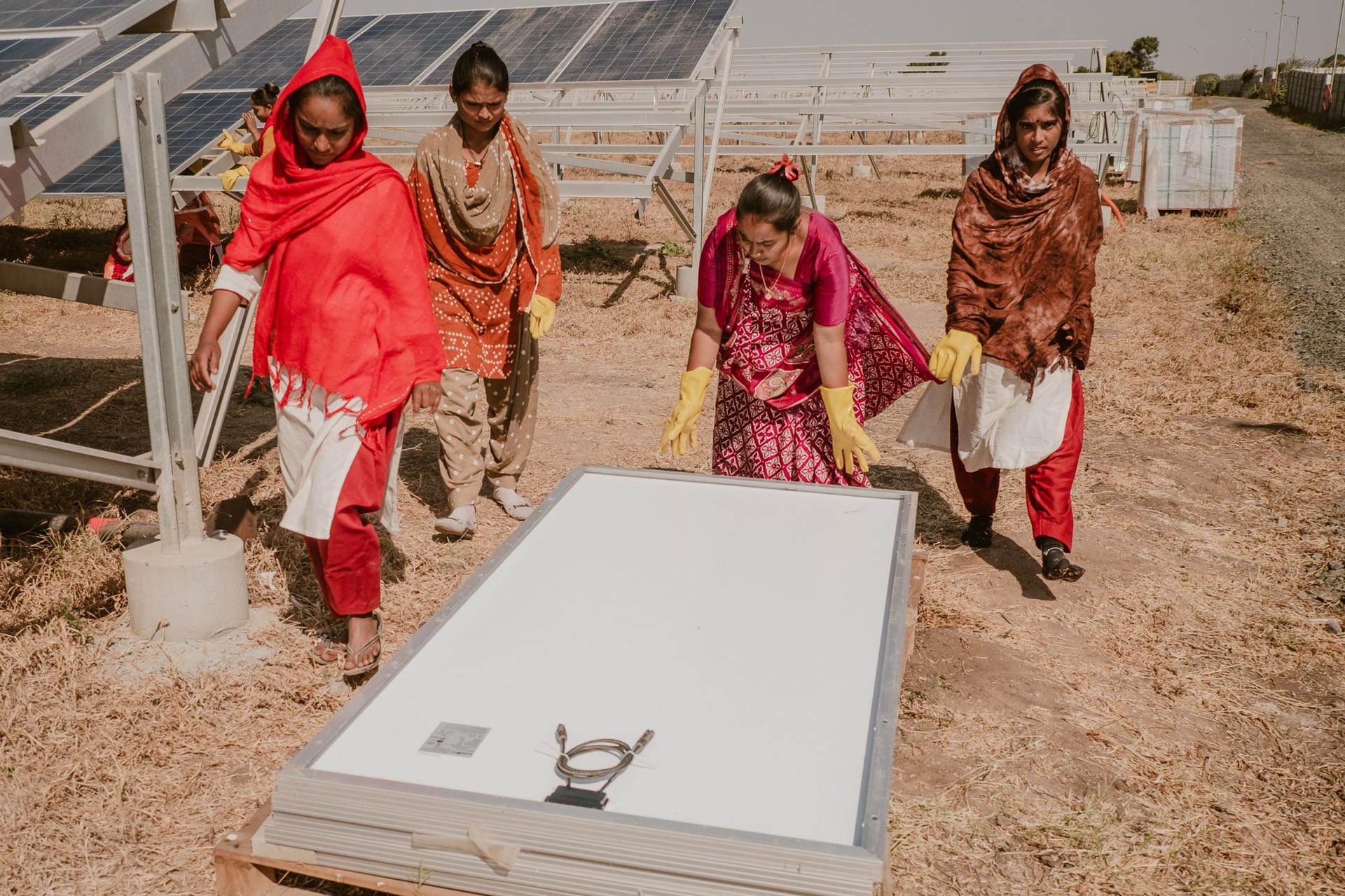
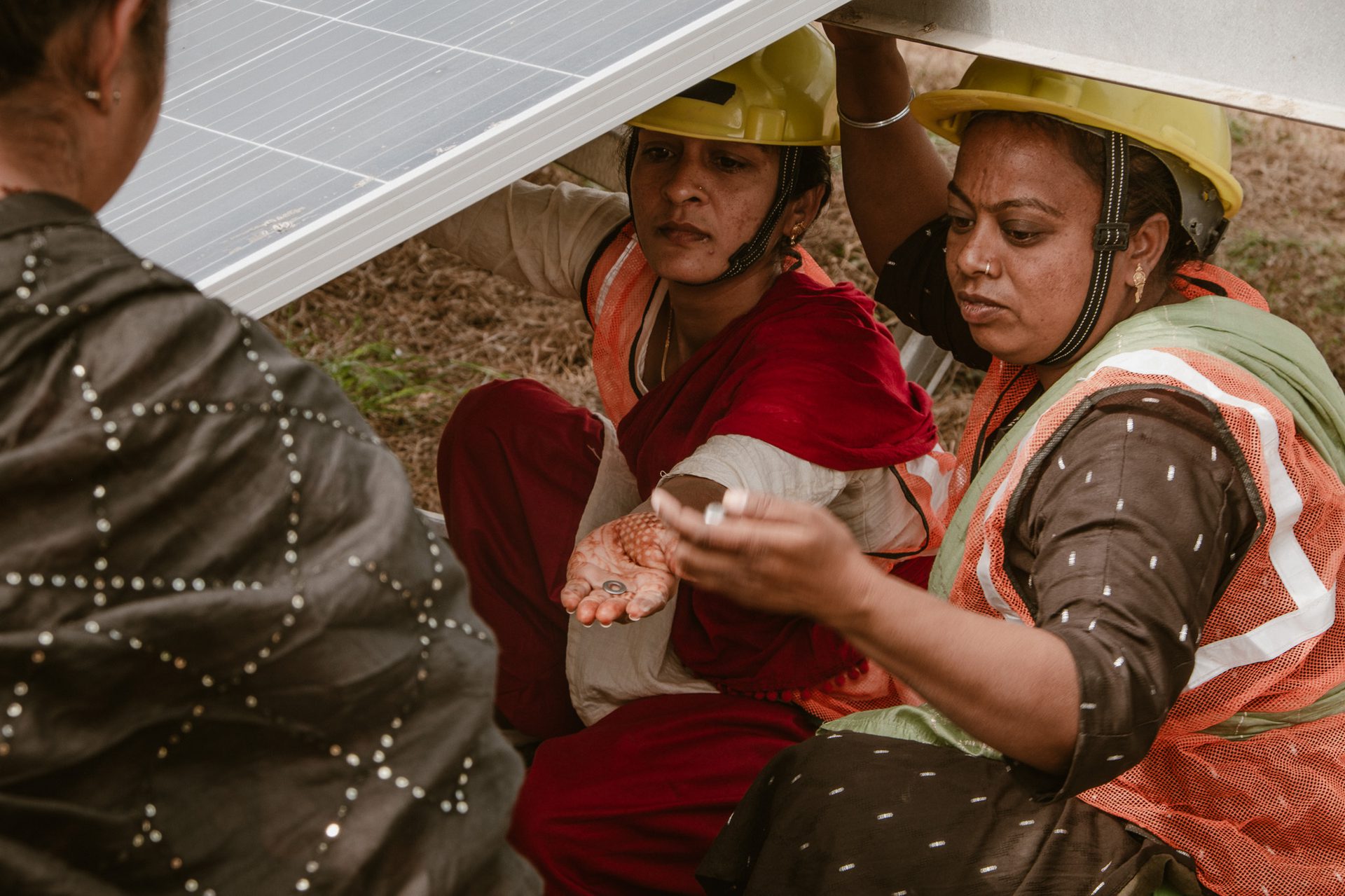
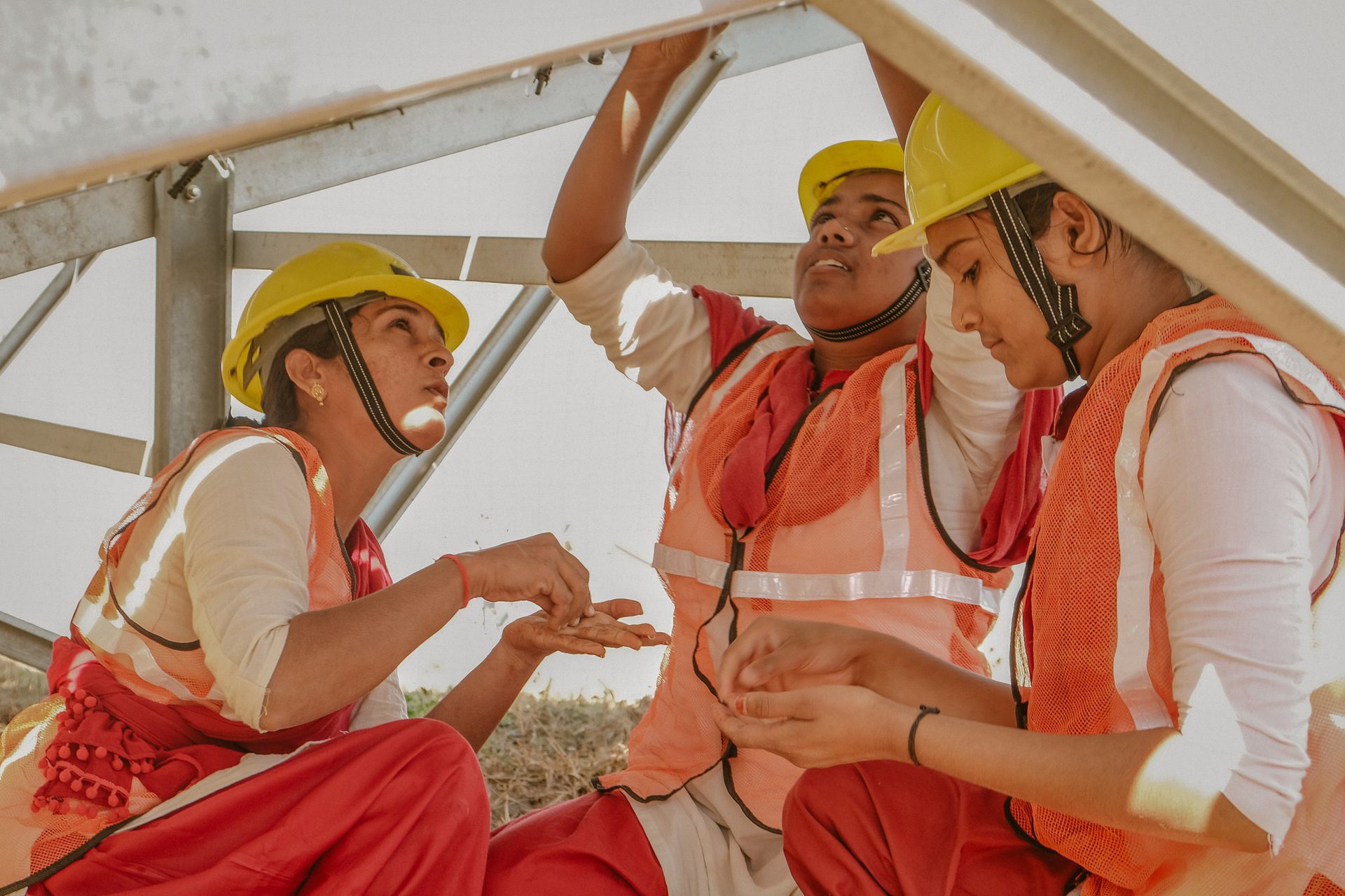
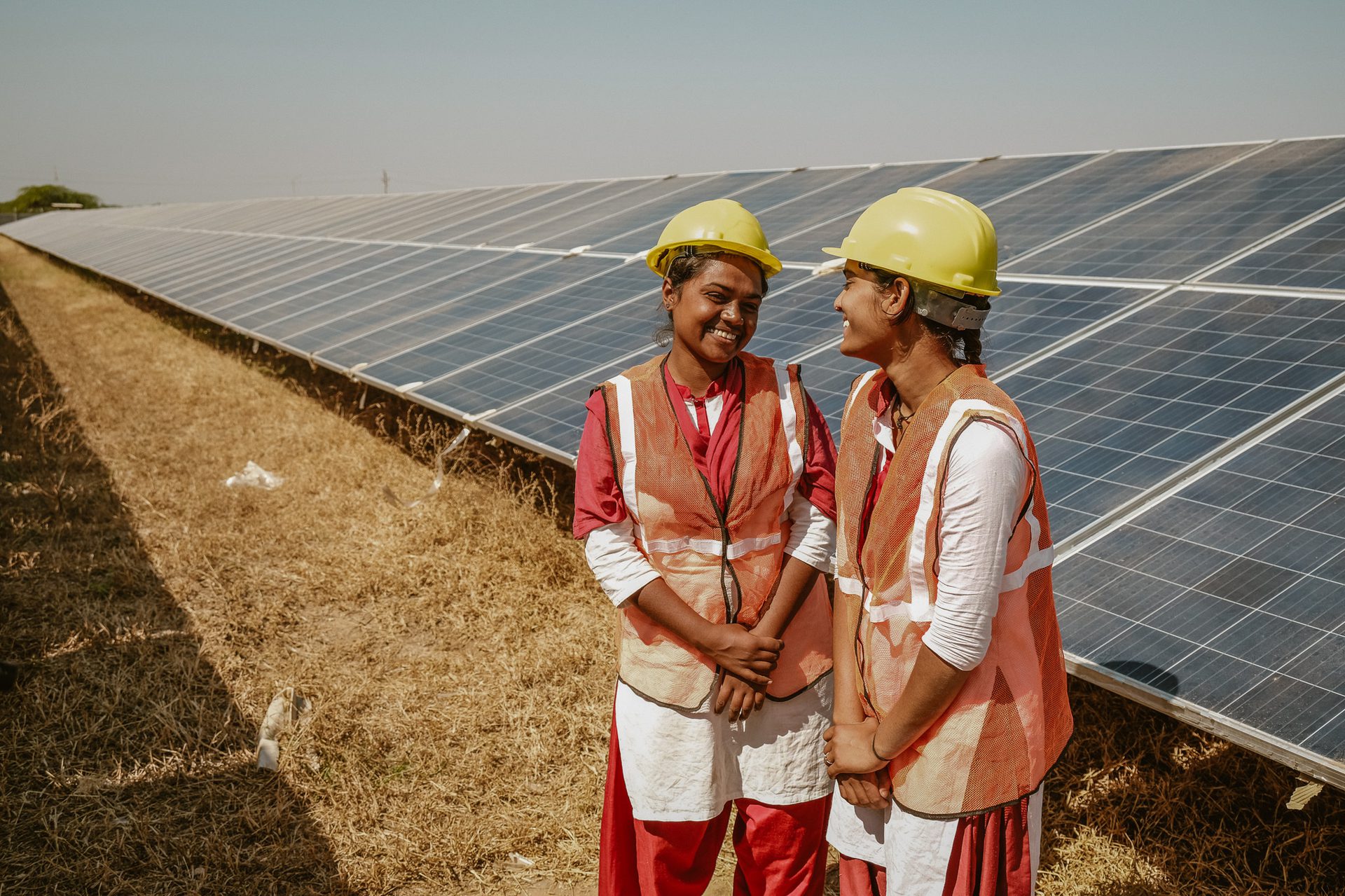
After the salt season ends, the Agariyas transport their solar panels to a site near Dhranghdhra, where the trained Agariya solar technicians install them to form a temporary solar park. (Credit: Oliver Gordon / IHRB)
SEWA also found that 70% of the participating women have been able to invest their additional income in improving their children’s education and healthcare. “We can now send our children to school without worrying about the cost,” says Manguben.
Manguben has found the solar pumps to be much more efficient than their diesel-powered predecessor. Consequently, she has repaid her loan on the first solar pump and purchased three more, now running four pumps continuously, which was never previously possible. Before the solar transition, her family produced 600-650 tons of salt each year. After adopting the new technology, their production nearly doubled to around 1,100 tons.
She now saves over ₹200,000 ($2,329) each season. These savings have allowed the family to pay off their loan; buy three extra pumps, a tractor and a motorbike; build two houses; pay for the education of Manguben’s nephews and nieces; attend social events like weddings; and generally improve their entire quality of life. “Before the solar panels, we would be struggling to make ends meet, and the off-season was an extremely stressful time. Now, not only do I save money on diesel, but I also earn from the solar park and my solar skills. My salt income has gone up by nearly 30%, and I can plan better for my family’s future.”
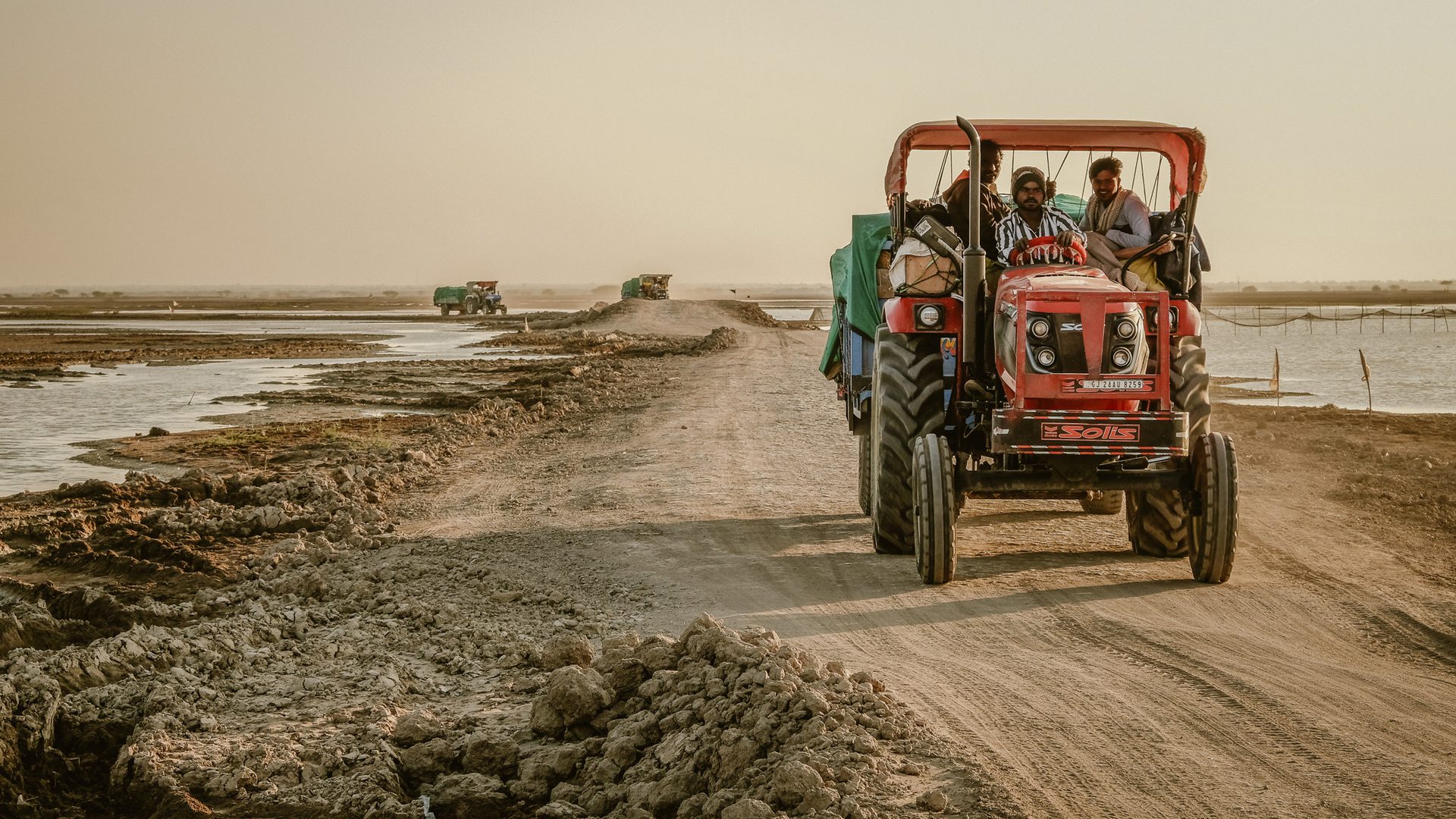
Tractors are essential for transporting salt and solar panels to and from the desert. (Credit: Oliver Gordon / IHRB)
On average, each solar pump reduces emissions by 2.7 tonnes of CO2 annually. The 7,000 pumps installed so far therefore reduce emissions by 18,900 annual tonnes of CO2 each year – equivalent to taking over 4,000 cars off the road. Furthermore, the solar park has a capacity of 2.7 megawatts of renewable electricity. “What started as a way to reduce the burden of diesel has now evolved into a model that not only saves money but also reduces our environmental footprint,” says Nananvaty.
Additionally, the 100,000 litres of diesel that are not burnt as a result of the project means less pollution and a significant risk reduction for the Agariyas’ health. “When I used to work with diesel pumps, my chest would often hurt from the fumes. I’m so relieved that those days are behind me,” remarks Manguben.
But for the women themselves, the impact of the project has been far more than just economic or environmental. For many the independence and autonomy it has engendered has completely changed their roles within their families and communities. For Manguben, it has engineered a newfound sense of financial independence. “Before, I would ask for permission to spend money. Now, I can decide for myself. I don’t have to ask anyone, and that feels empowering,” she says.
For Payal Dharamsibhai Metalia, a 21-year-old Agariya woman who joined SEWA three years ago to train as a full-time solar engineer, the increased income and autonomy have shifted the power dynamics within families, allowing the women to make decisions that were once out of reach, including how to allocate household resources and invest in their children's future. “Before we joined SEWA, we were seen as helpers in the household, but now we’re seen as contributors. I can support my siblings' education, and I’m proud of that,” she says.
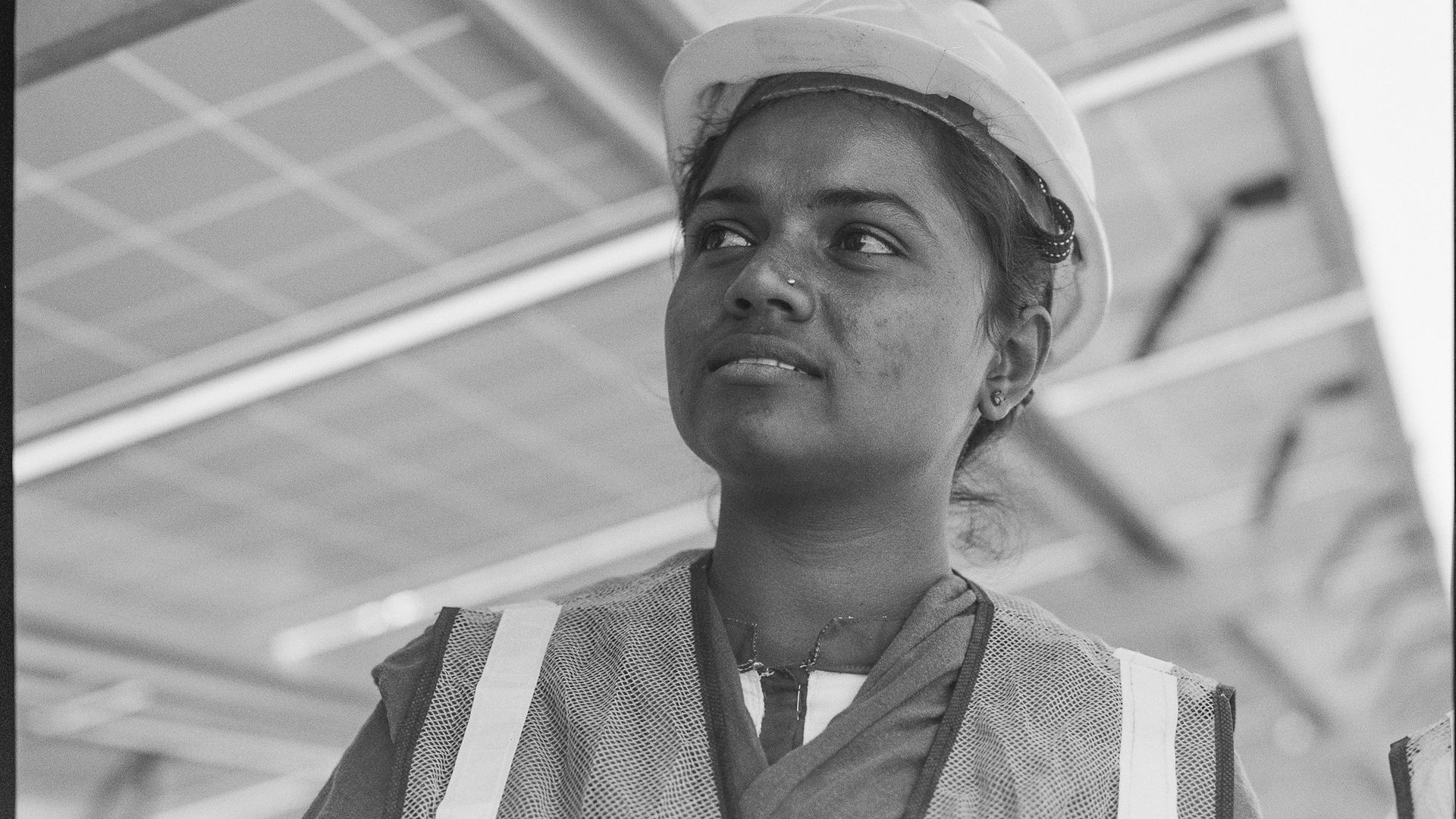
Payal Dharamsibhai Metalia, a 21-year-old Agariya woman who joined SEWA three years ago to train as a full-time solar engineer. (Credit: Oliver Gordon / IHRB)
Saniya Salimbhai Divan, an 18-year-old third-generation SEWA member, now proudly supports her elder brother’s higher education using her newfound income of ₹400 ($4.66) per day, contributing to his MSc fees – a step that she could never have imagined before joining SEWA.
Manguben has noticed that her neighbours are increasingly encouraging their daughters to associate with her, in the hope of joining SEWA and accessing similar opportunities. “I feel like I’ve stepped into a new world. I’m no longer invisible. I can make decisions for myself and my family. And when I see the change in my children’s lives, I know that I am building a better future for them.”
Beyond the underlying energy transition, SEWA’s project has allowed many of these women to aspire to higher education, professional careers and the ability to contribute meaningfully to, and even lead, their communities. Both Payal and Saniya plan to use their incomes to pursue higher education. “Before joining SEWA, we didn’t even have dreams. Now, I see a future where anything is possible,” says Payal.
Before we joined SEWA we were seen as helpers in the household, but now we’re seen as contributors.
While formal unions play a crucial role in advocating for labour rights, ensuring fair wages and improving working conditions at the national level, informal workers like the Agariyas typically find themselves excluded from these protections. Without the support of formal unions, many workers in the informal economy – especially women – face exploitation, lack of social security and limited bargaining power. Organisations like SEWA are essential to bridging this gap by organising informal workers like salt farmers, street vendors and waste pickers, offering them a platform to voice their concerns, negotiate better wages and advocate for their human and labour rights.
For Alison Tate, former Director of Economic and Social Policy at the International Trade Union Confederation (ITUC), the powerful model SEWA and its partners have created through the project “shifts the members from being ‘price takers’ in the salt market to ‘price makers’ – and no longer dependent on the price of diesel. It represents a fundamental shift for women workers who for generations have been exploited. They now have economic power and dignity, the power to transform their own working conditions and their future.”
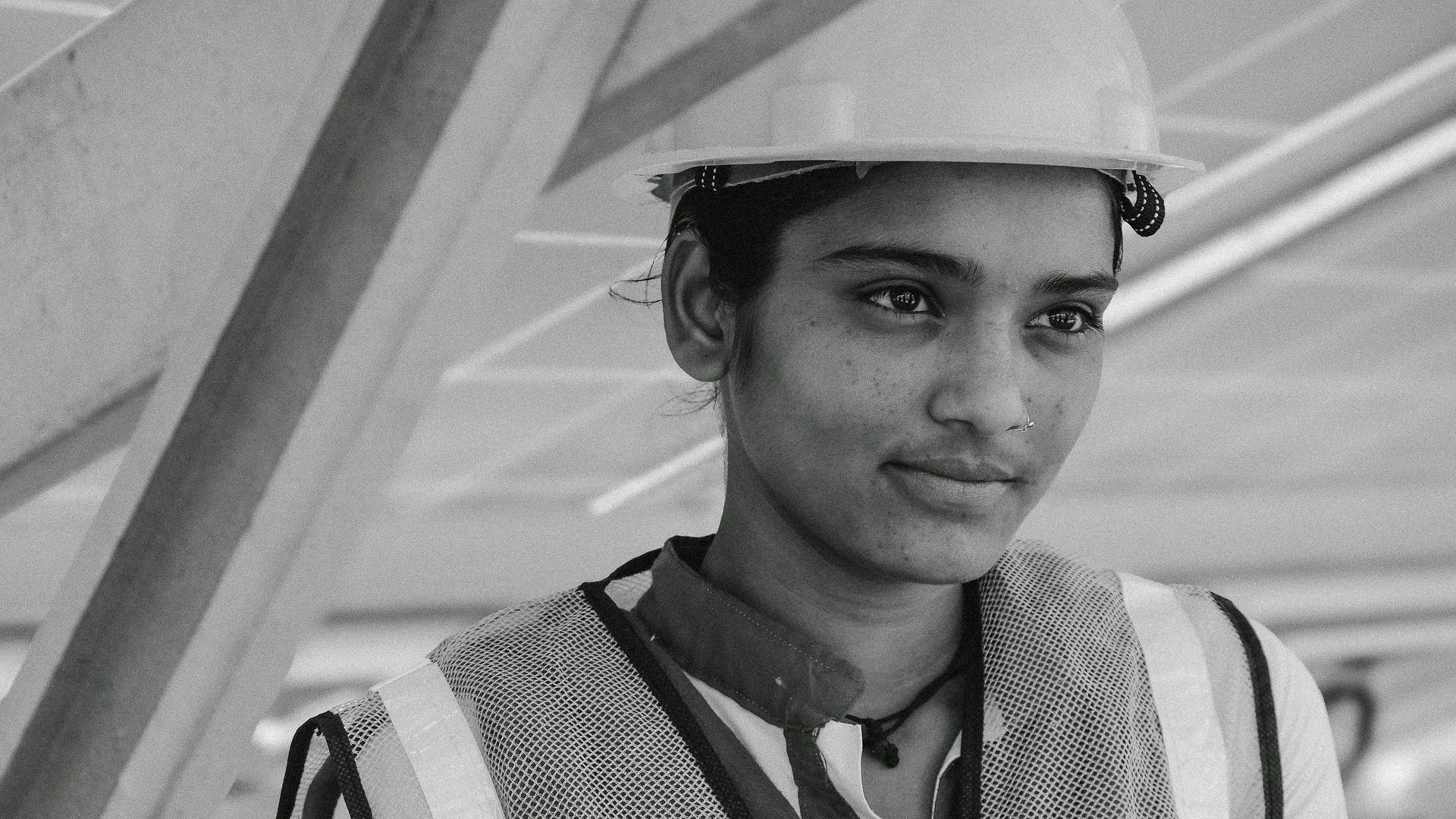
Saniya Salimbhai Divan, an 18-year-old third-generation SEWA member. (Credit: Oliver Gordon / IHRB)
A scalable solution
Indeed, beyond the desiccated flats of Surengranagar, SEWA’s underlying model offers untold promise both within India and elsewhere in the world. Its obvious application would be in non-industrialised salt industries, but it also could be applied to other small-scale, informal sectors where workers rely on fossil fuel-powered production to make their living, offering the potential to supercharge the world’s just transition to net zero in the process.
By offering legal support, financial inclusion and access to clean energy solutions like solar-powered pumps, SEWA empowers the women to assert their rights in their workplace and community. The programme also fosters gender equity by challenging traditional power dynamics, ensuring that women are not only treated fairly but are also given the opportunity to lead and advocate for their own rights in the salt farming sector.
The powerful model shifts members from being ‘price takers’ to ‘price makers’ – no longer dependent on the price of diesel. It represents a fundamental shift for women workers who for generations have been exploited.
Scaling SEWA’s programme – which is still in its infancy – to the 43,000 Agiriya families in Gujarat’s Rann of Kutch region could save roughly 115,000 tonnes of CO2 each year, roughly the equivalent to taking 25,000 cars off the road, according to NRDC’s estimates. But across the entirety of India, some calculate there to be as many as 150,000 salt-pan workers. Although an official analysis hasn’t been done, if each of these workers exchanged their diesel-powered pumps for solar equivalents, and achieved the same emissions reductions as seen in SEWA’s project (2.7 tonnes of CO2 per year), this would reduce roughly 400,000 tonnes of CO2 emissions each year.
Similarly, there are thought to be several hundred thousand more artisanal salt farmers across the world, particularly in China, Bangladesh, Ethiopia, Indonesia and Senegal. Many of these are either wholly or partially reliant on diesel-powered pumps to either extract brine from subterranean water tables, or to manage the distribution of brine from the sea at coastal pans. If all were to switch to solar-powered pumps, this would equate to well over one million tonnes of CO2 emissions saved every year.

But SEWA’s solar model is not limited to the salt industry, and there are many more fossil fuel-reliant sectors across India and the world, from construction materials to textiles to agriculture, that could reap its benefits and bolster the power of informal workers. “Several other entities are now trying to use similar models with underserved micro-enterprises and other low-income borrowers,” says Sharma. “Business models differ among sectors but what is scalable is the basic solution: an ability to aggregate and motivate borrowers to borrow, productively use and service affordable credit, a transition from fossil fuels, green skills and financial literacy training, and a risk mitigation structure for lenders.”
Artisanal brick kilns, mainly found in emerging and developing economies, are major contributors to global greenhouse gas (GHG) emissions and air pollution. They are typically small-scale, informal operations that often rely on inefficient firing methods and polluting fuels like coal. Approximately 1.5 trillion clay bricks are produced worldwide each year, with about 90% of this production based in Asia. The coal consumed by the brick industry in the top five Asian brick-producing countries emits 1.2% of all global anthropogenic CO2 emissions. Transitioning these brick kilns to solar power, as seen recently in Uttar Pradesh, could make a huge dent in the world’s emissions-reduction target and – if using SEWA’s model – could improve the quality of life for the 16 million workers employed across South Asia.
Similarly, the global textiles industry produces 3-10% of the world’s annual GHG emissions, with roughly 35% of the 450 million-strong global workforce employed informally in countries like India, Bangladesh and Pakistan – 75% of whom are women. For instance, in Bangladesh, an estimated 7,000 informal garment factories operate, employing tens of thousands of workers – predominantly women – under precarious conditions. But, according to Tate, solar cooperatives in garment factories, particularly rooftop solar installations, could provide more regular electricity, and stable working hours and income for garment workers, as well as access to power at home. “This model is seen in various countries, including South Africa (where unions are involved), Brazil, Senegal and Indonesia, and can be implemented through worker cooperatives or other collaborative structures,” she says.
But perhaps the most exciting application for SEWA’s model would be to replace diesel-powered irrigation pumps on the world’s small-scale farms. The 600 million smallholder farmers around the world, predominantly based in low-income countries, produce a third of the world’s food, and many rely on diesel-powered pumps to irrigate their farms. According to research, solar powered irrigation systems can cut these farmers’ energy costs by 80% and reduce emissions by 95%; and in Kenya, Tanzania, and Uganda, research from International Water Management Institute found that these systems have led to increases in annual yields by 30-60%. In India alone, it is estimated that 5 million solar-powered irrigation pumps could save 10 billion litres of diesel, reducing emissions by 26 million tonnes, according to CEEW research.
“The scalability of this model for solar irrigation pumps for small-scale farmers is absolutely massive,” says Kamya Choudhary, India Policy Fellow at the Grantham Research Institute on Climate Change and the Environment. “But the training and capacity building are fundamental. I’ve seen it so many times: the cleantech breaks and there’s no-one to fix it, so it's disregarded and the farmers return to the old ways.”
The training and capacity building are so fundamental. I’ve seen it so many times: the cleantech breaks and there’s no one to fix it. So it’s disregarded and the farmers return to the old ways.
Indeed, the training facet of SEWA’s model not only addresses this issue, but also solves a secondary problem facing governments everywhere: a lack of green skills to build the net zero transition. According to the ILO, there is a projected shortfall of 85 million green jobs by 2030, particularly in renewable energy, sustainable agriculture and energy efficiency. And through the likes of Manguben, Saniya and Payal, SEWA is providing India with a new generation of skilled technicians to drive the country’s green transition. “Investing in green jobs for informal workers doesn’t just meet energy demands – it accelerates the global transition to net-zero and builds new opportunities in a sustainable economy,” says Choudhary.
And of course, empowering these informal sector workers also meets their economic demands too, which in turn could offer a significant boost for the global economy at a time it needs it most. There are currently 2 billion informal sector workers, representing 58% of the world’s working population (90% in low-income countries). According to the ILO, formalising these workers would provide them with better wages, benefits and legal protections to contribute more effectively to their economies, which could lead to a boost in global GDP by as much as 15% and add $6 trillion in the global economy. “The process of formalisation is fundamental to a just transition and the protection of vulnerable communities against the negative impacts of climate and environmental change” says Alison Tate.
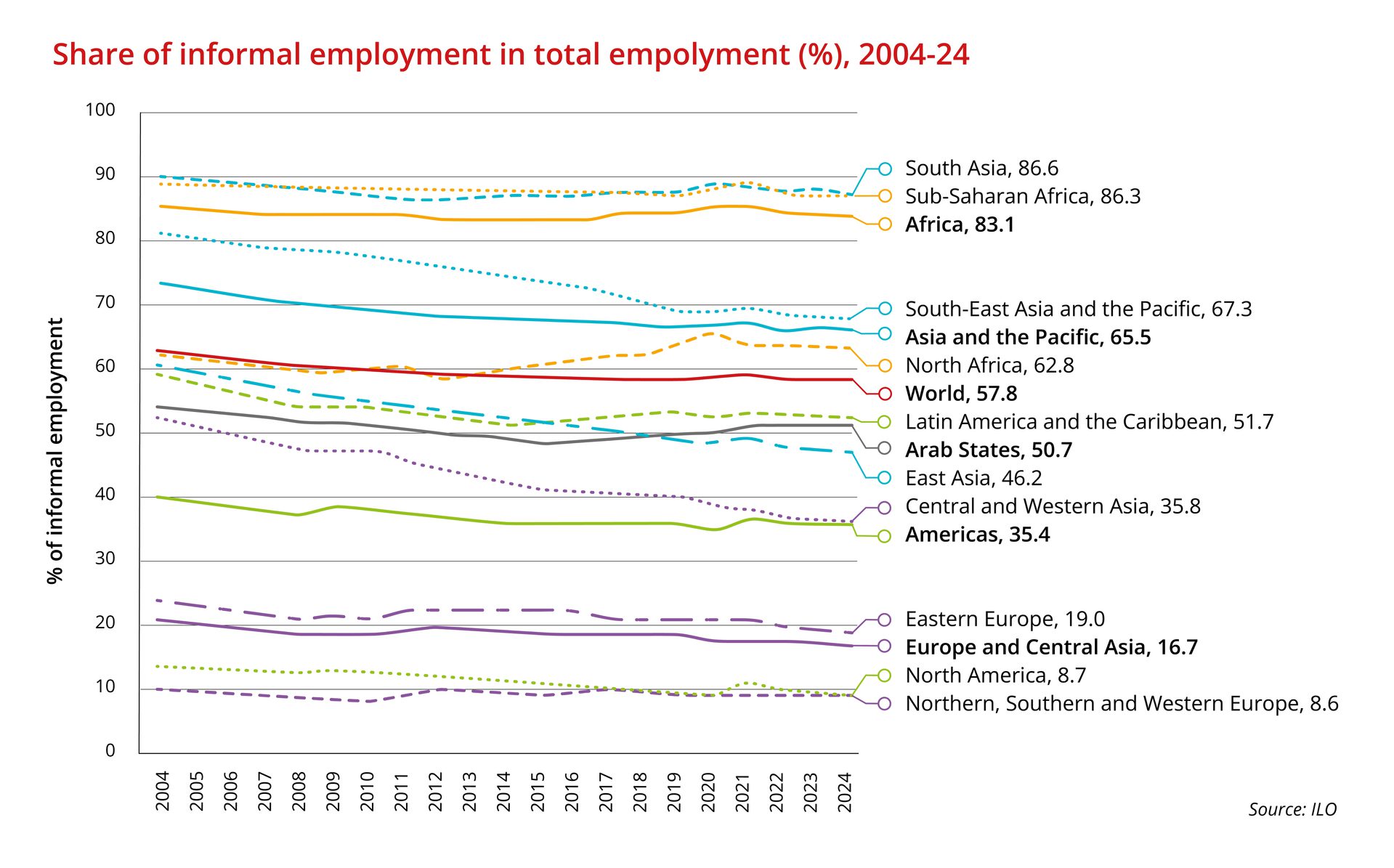
“Organising workers in informal employment offers huge potential benefits to the workers themselves, to their families and to the economy. There are organisations and networks of informal workers around the world; from salt farmers in India to waste-pickers in Latin America,” adds Martha Chen, former lecturer in public policy at the Harvard Kennedy School and founding international coordinator of the global research-policy-action network Women in Informal Employment: Globalising and Organising (WIEGO). “These organisations engage in collective bargaining and advocacy for policy change; some operate as cooperatives to pursue their trade.”
A greener world must also be a just one
But perhaps most important is the potential that the model offers specifically for the 740 million women working in the world’s informal sector, without whom reaching net zero will remain a pipe dream. In countries like India, Bangladesh and Ethiopia, these women face a web of overlapping oppressions that intersect with issues of gender, class and race – the Agariyas, for instance, are of the Chunvalia Kolis caste, classified as an “Other Backward Class” by the Gujarat government. Yet such women are often the end users of leading climate solutions such as clean cookstoves, solar irrigation systems and solar-powered sewing machines. The proliferation of these solutions must therefore serve to empower them both socially and economically, rather than preserve the existing inequities of the fossil-based economy. Under international human rights law, women everywhere have the right to live free from discrimination, the right to education, the right to health, the right to own property, the right to work and the right to equal opportunities.
“If we are serious about reaching net zero by 2050, we must recognise that women in the informal economy hold the key,” says Choudhary. “They are the ones who will implement renewable technologies, from solar power to green agriculture. If we leave them behind, we won’t reach Net Zero.”
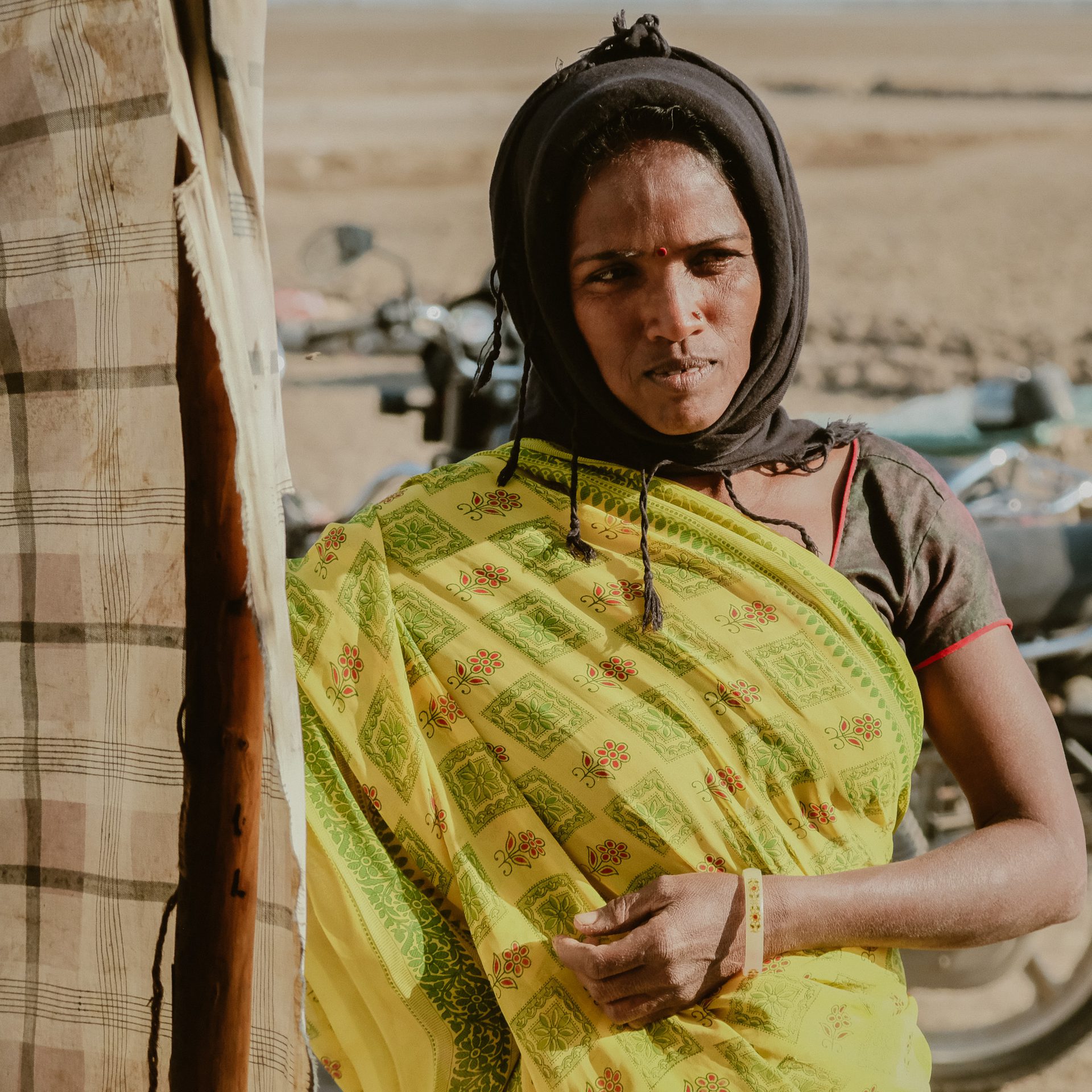

Agariya women are expected to do the most laborious and back-breaking of the salt-farming work. (Credit: Oliver Gordon / IHRB)
Women in the informal sector are often excluded from decision-making related to energy access, technology adoption and financial services. SEWA’s model empowers them to not just adopt green technologies, but also to own and control them, ensuring access to the benefits that accrue from them. This not only enhances their income but also their social status in communities, allowing them to move from economic marginalisation to positions of leadership and economic self-sufficiency. The ability to contribute financially and to make decisions for their families is a critical component of gender equity and equal rights. Collective action models like SEWA’s also provide a collective voice to women who would otherwise be silenced in policy conversations that shape their future.
"Countries like Benin are already seeing the sense in centring women in their solar irrigation programmes” says Choudhary. “A greener world can also be a juster one; gender-neutral approaches can end up preserving the existing hierarchies.”

The green transition holds the potential to either rectify past gender injustices associated with the fossil-based economy, or perpetuate them. Currently, women are projected to hold a mere 25% of global green jobs by 2030, according to the Boston Consulting Group. "Green transition is a chance for social change,” says Choudhary. “The fossil economy often led to male-dominated sectors, as seen in hard-to-abate industries. But now, the green economy is emerging as an opportunity to correct this imbalance. Women can be at the forefront of the transition, shaping the future while ensuring that the benefits of this transition and green jobs are equitably distributed.”
For a transition to net zero to be just, it must be inclusive; ensuring that those who have been historically marginalised are not just participants but leaders in the process. And addressing the structural sexism of the fossil-based economy offers the opportunity to benefit not just women, but society as a whole. These women have the potential to be the agents of change in driving the green transition and ensuring that global climate goals are met. “It’s not just women who benefit from SEWA’s model,” says Kwatra. “It’s by women but for families. And we’ve seen time and time again that women make the best agents of green transition.”
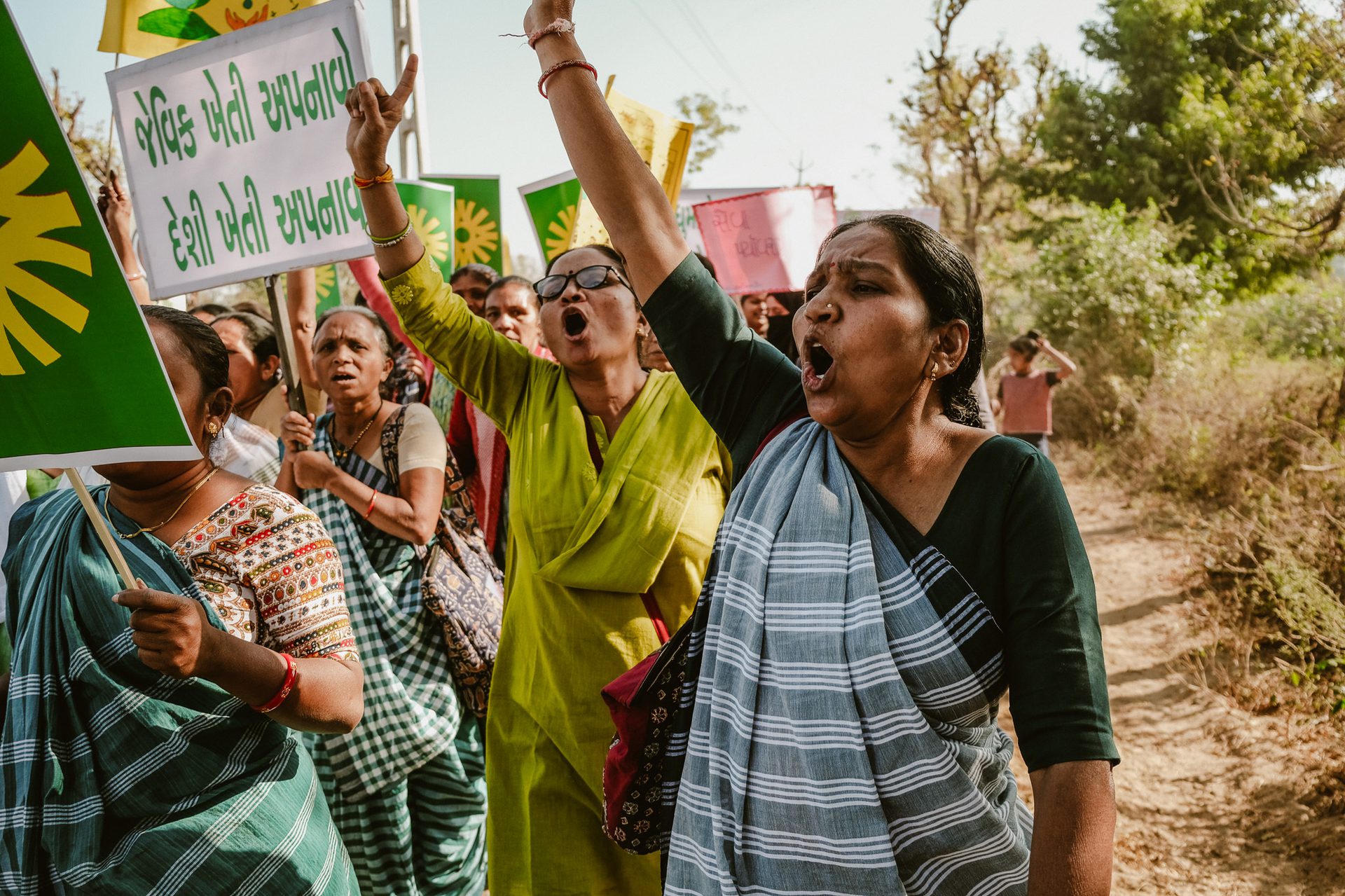
SEWA holds rallies in rural villages to create awareness of climate change. (Credit: Oliver Gordon / IHRB)
Indeed, global research indicates female leaders are more likely to support climate action and sustainability. For instance, countries with a larger share of women in Parliament are more likely to ratify environmental treaties and adopt policies that address climate change. And in the private sector, studies show that companies with a larger share of women on their boards are more likely to improve energy efficiency, reduce firms’ overall environmental impact and invest in renewable energy.
And then there’s the economic imperative: the World Bank estimates that closing the gender gap in employment and entrepreneurship could increase global GDP by more than 20%, while the International Monetary Fund (IMF) has categorised the correction of the “misallocation” of women’s talents and abilities as a method for boosting productivity. By formalising informal sector workers, especially women, and empowering them to participate in the green economy, countries can unlock this massive economic potential while simultaneously advancing gender equity.
Indeed, unionisation empowers women to demand recognition, improve their working conditions, and ultimately secure better economic and social outcomes, thus promoting their labour rights in a way that formal unions do for their members in the formal sector. By organising informal workers, SEWA is helping to ensure that their labour rights are respected and realised, providing them the opportunity to improve their status both within their communities and in the broader labour market.
“Women in the informal economy are often the backbone of their communities,” says Chen. “When you empower them, such as through access to green technologies, you’re not just helping individual women – you’re laying the foundation for a more sustainable and equitable future for communities and economies.”
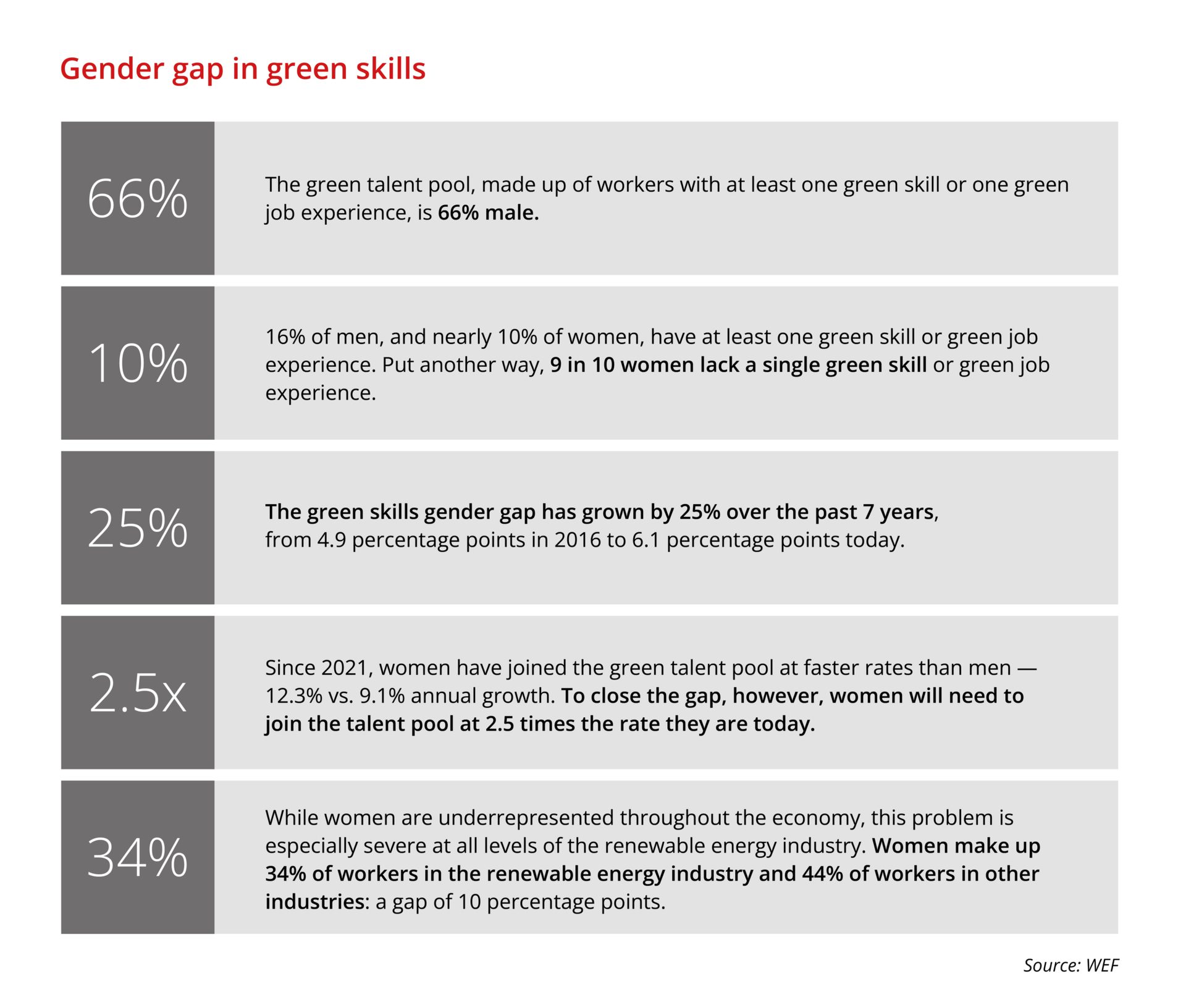
“We learned from those mistakes”
But for those looking to replicate SEWA’s model elsewhere – for salt farmers, informal sector workers, women or otherwise – there are a number of key lessons to bear in mind; lessons SEWA and its partners learned the hard way.
The main initial hurdles to getting the project off the ground were the high upfront capital cost of the solar infrastructure and the women’s lack of access to traditional credit to finance it. “We knew the technology would change lives, but without financing, it wasn’t going to happen,” recalls Dave. “The women didn’t have the collateral to get loans from commercial banks.”
To overcome this issue, SEWA and IFC designed a worker cooperative model, complemented by a risk mitigating blended-finance instrument, where the women collectively pooled their resources to fund the solar infrastructure, bypassing the need for individual loans and sharing the financial burden – but also giving the women ownership over the solar systems. “The innovation in SEWA’s financing model lies in its ability to harness the power of community and collective ownership,” says Kwatra. But crucial to convincing the banks to lend to these previously ‘unbankable’ families was SEWA's role in providing KYC (‘Know Your Customer’) documents for the women and aggregating demand, as well as customising repayment schedules to match the women’s income patterns, according to Kwatra.
Another problem at the start was the regulatory and policy landscape within India. When the programme was being set up, there were energy policies and subsidies available to renewable energy projects, but not for small-scale, community-owned ones like SEWA’s. “We were pushing a boulder uphill,” says Dave. “The policies were designed for large corporations, not for small cooperatives like ours. But we weren’t going to let bureaucracy stand in the way.”
To solve this, SEWA and NRDC spent over a year advocating to government agencies, including MNRE and local energy authorities, to includes community-owned solar projects into the renewables subsidy scheme, and then to permit the solar park to connect to the national grid. “Policy changes don’t happen overnight,” says Kwatra. “But SEWA’s ability to advocate for small producers shows the importance of centring worker-led initiatives in energy policy. This can be a game-changer for renewable energy access, especially for those who need it most.”

Although SEWA’s project is aimed at women, Agariya men are also allowed to attend any of the training or workshops. (Credit: Oliver Gordon / IHRB)
Then there was the lack of technical expertise among the women, none of whom had worked with anything remotely like solar technology before. As a result, the training programmes were designed to be hands-on and accessible, allowing workers to build their technical capacity from the ground up. SEWA also included a mentorship model where trained technicians helped guide new learners. Over time, this approach fostered a culture of self-sufficiency, with workers gaining confidence in their ability to manage the technology. “When we first installed the panels, nothing worked right; there were so many mistakes and frustrations,” recalls Payal. “But the training made all the difference. We learned from those mistakes, and now I’m confident in my ability to maintain the system without help.”
But probably the most difficult challenge the project had to overcome was building sufficient trust among the Agariya community. The Agariyas have long been a marginalised community within the region, even being labelled a ‘Criminal Tribe’ by the British colonial authorities, and are distrustful of outsiders as a result. So when SEWA asked to take away the women of the families, who are traditionally considered under the protection of the men, to some mysterious ‘education programme’ many miles away, there was naturally considerable scepticism among the community. “Building the trust with the community to allow the women to leave their villages and go train elsewhere was a huge challenge,” recalls Bagai. “The first two years of the programme were a tough slog.”
Bagai and others understood that trust had to be earned. Rather than rushing into large-scale implementation, they took a gradual approach. They started with pilot projects, which allowed the workers to experience the benefits of solar technology firsthand. And importantly, they also allowed the Agariya men to attend any of the training, workshops or meetings, so that they could see the women were safe and learning important skills. And slowly, success stories and enthusiasm for the training began to spread organically throughout the community, and that word-of-mouth built an inexorable momentum behind the programme. “Once we saw the difference it made in our lives, we told our neighbours. It wasn’t just the leaders – every worker became an ambassador,” says Saniya.
On the whole, there is a simple set of instructions for anyone looking to replicate SEWA’s model: cultivate trust among the local community and work with its members to co-create a solution to their stated problems; build local evidence that the solution works in your specific context; secure access to subsidies or financing mechanisms; ensure financial inclusion through organisations that can provide intermediation between banks and communities; develop local capacity by investing in people who can persistently work on the project over time; and combine effective technology with patient organisations, financial intermediation and enabling government policies. Once a concept is proven and people see the financial benefits, subsidies can be gradually reduced.
“My only worry about scaling the programme elsewhere is that it takes time and dedication from all involved, and what other organisation in the world fosters as much loyalty and commitment from its members as SEWA does,” warns Kwatra. “That’s been so critical to the success of all of this.”
Grand plans
Luckily, SEWA shows no sign slowing down. Looking ahead, it plans to expand the programme to 10,000 salt-pan workers across Gujarat over the next five years, and then subsequently across all of India. “We want to extend this transformation to all India’s salt-pan workers and to other sectors like farming and waste recycling,” says Nanavaty. “Our goal is to create a larger, more inclusive cooperative model that empowers women to take control of their energy sources and their futures.”
To help achieve this, SEWA is advocating to the government to include women in the informal sector in its official Just Transition policy, and also to set a minimum price for salt – as it does in other formal agricultural sectors. The organisation is also looking to greatly expand its use of carbon credits. UNEP is also currently in discussions with ReNew to help scale up the salt programme in India, according to Bagai, “first, in the Rann of Kutch, and then in two other states,” he says. “We’re also looking to try it in two non-salt sectors in two other states.”
The main challenge facing these grand plans, according to Nanavaty, is climate change itself. “Increasing heat waves, unseasonal rain and climate disasters are making it more difficult to harvest the salt consistently in the salt pans and is undermining the business model,” she says.
But SEWA has already started integrating the model into its other development programmes. Chief among those is its Hariyali Gram (Green Village) programme. In partnership with NRDC and India’s MNRE, the project aims to provide a comprehensive suite of climate solutions for small-scale farmers and rural communities, including solar-powered irrigation, LED bulbs for lighting, energy efficient fans for thermal comfort, biogas plants for clean cooking, cool roofs to reduce heat stress in houses, precision irrigation systems to reduce water usage, and solar trap lights and solar fodder systems to improve farm productivity. “It’s about creating the model village of the future,” says Kwatra.
As well as the energy efficiency and solar technician training, the women are trained in sustainable agriculture practices, increasing productivity and financial security. The programme is currently being implemented in 100 villages across several states.
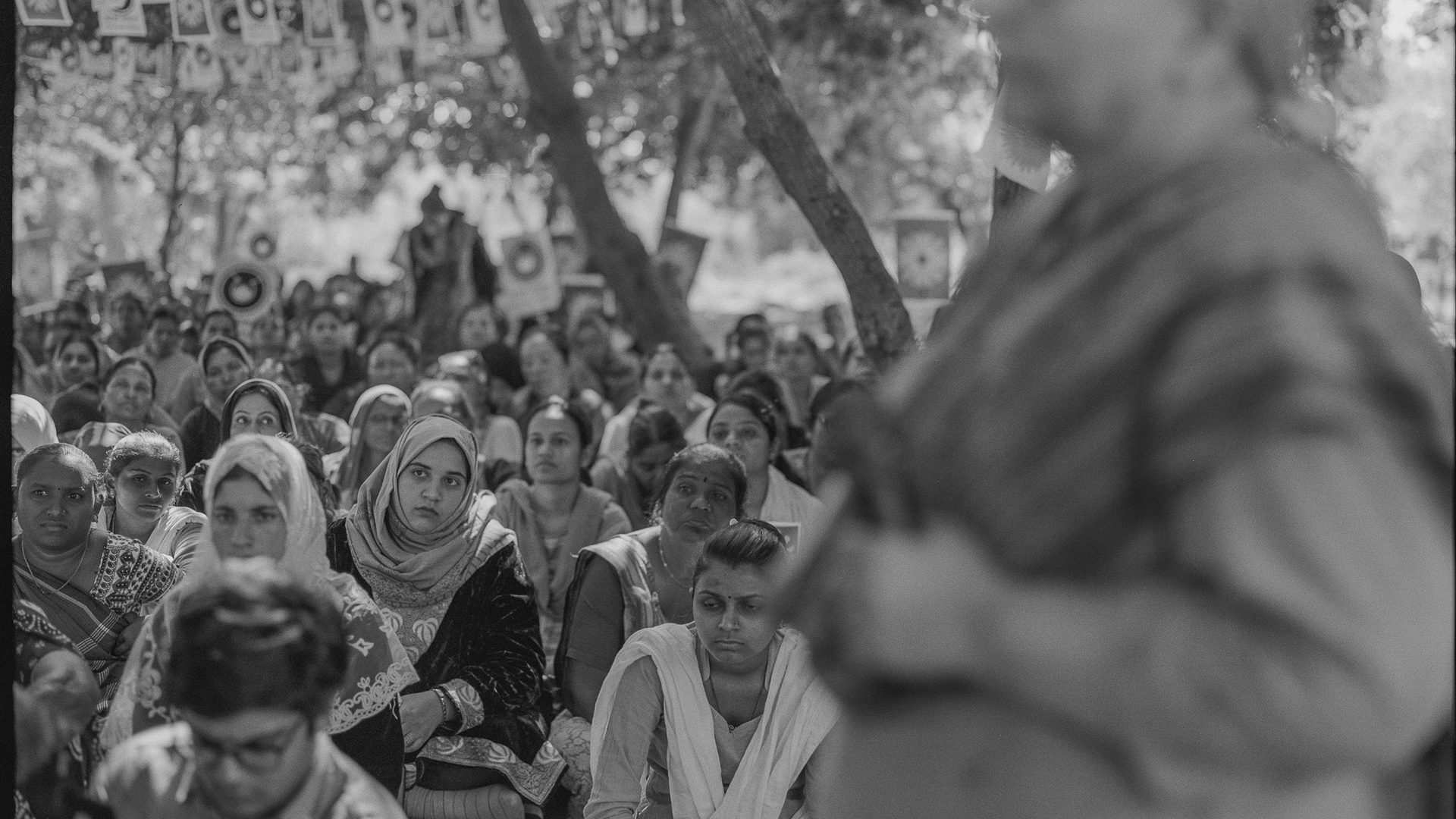
A gathering of SEWA members at an event for the Hariyali Gram programme. (Credit: Oliver Gordon / IHRB)
Similarly, in 2021 SEWA used its salt-farmer model to launch a programme to support India’s 2.5 million waste-pickers with solar-powered equipment to sort and process waste more efficiently, reducing the environmental impact of the waste-picking process and improving workers’ conditions.
On its own accord, ReNew is now expanding its solar training programme to other parts of the country. The company has started a similar programme to train coal workers as solar technicians, having already trained 100 women, and is now developing new programmes for other underserved groups, such as women fishers. “We’re aiming to train 2,000 women in the next two years, and we won’t stop until we’ve green-skilled at least 50% of the country,” adds Sinha.
The success of the salt farmer programme is also garnering admirers abroad, with various international organisations, NGOs and philanthropies now looking to use the model to support informal sector workers in other low-income countries. In 2020, SEWA was selected as a partner in the Just Energy Transition’ initiative by the United Nations Development Programme (UNDP), which promotes equitable and sustainable energy transitions in vulnerable regions. The collaboration aims to provide access to clean energy for informal sector workers globally, using SEWA’s cooperative model as a foundational strategy for empowering women and reducing reliance on fossil fuels.
And after Hilary Clinton visited Gujarat’s salt pans in 2023, the Clinton Foundation announced the $50 million ‘Global Resilience Fund’ to scale the SEWA model to help women in other low-income countries fight climate change. The fund aims to empower women and build their climate resilience by enabling access to affordable and innovative financing solutions to adopt adaptation and mitigation solutions, as well as enabling women's inclusion in formal financial systems. “It’s at a feasibility study right now, and we expect a pilot this year sometime,” says Sharma.
SEWA is also in talks with the International Solar Alliance with the aim of scaling out the solar entrepreneur model to informal sector workers across Africa. “We are seeing a growing interest in SEWA’s model because it is a bottom-up, worker-driven approach that has proven to be both economically viable and socially transformative,” says Kwatra. “This is a model that can be adapted to different contexts, whether it’s for salt workers in Gujarat, farmers in Africa, or women in Southeast Asia.”
There are, however, potential unintended consequences to consider when encouraging the increased use of the model. “It is worth keeping an eye on the increasing levels of water use and solar e-waste that could come from scaling programmes like this,” warns Choudhary. “It could prove a problem down the line, and there needs to be a plan for sustainable use and recycling, as that’s not really being considered in Global South energy transitions right now.”
Indeed, there is no such thing as a silver bullet in the world’s Sisyphean search for a just transition to net-zero emissions. Nonetheless, the success of SEWA’s salt-pan worker programme does demonstrate the power of collective action and cooperative ownership in scaling renewable energy initiatives; not only allowing workers to own their energy sources but also providing a platform for women to take leadership roles within their communities. And at its heart, SEWA’s model proves that clean energy access and gender empowerment can go hand in hand.
“Climate change is not just an environmental issue, it’s a human rights issue. A just transition means recognising and removing the barriers that prevent the most vulnerable from participating in the solutions,” concludes Robinson. “SEWA’s model shows the power of the feminine: non-hierarchical, practical, collaborative, united. But importantly, it’s women-led but it’s not just for women – society as a whole benefits.”

Mary Robinson meeting Agariya solar technicians at the community solar park near Dhranghdhra. (Credit: Oliver Gordon / IHRB)
So tonight, as you reach for the salt shaker on your dinner table, spare a thought for the journey this humble commodity has taken to reach you. This unassuming staple of quotidian life carries with it the invisible labour of countless workers who have toiled in some of the planet's harshest working conditions. But for some of these workers out in the remote salt pans of Gujarat, a transformation is underway; one that brings hope, not just to the world’s informal sector workers and their communities, but also to the global fight against climate change.
"Before, I felt like a prisoner to the salt pans and the debt I owed,” says Manguben. “Now I feel free – free from pollution, free from debt. I’m part of something bigger, something that can change the world.”
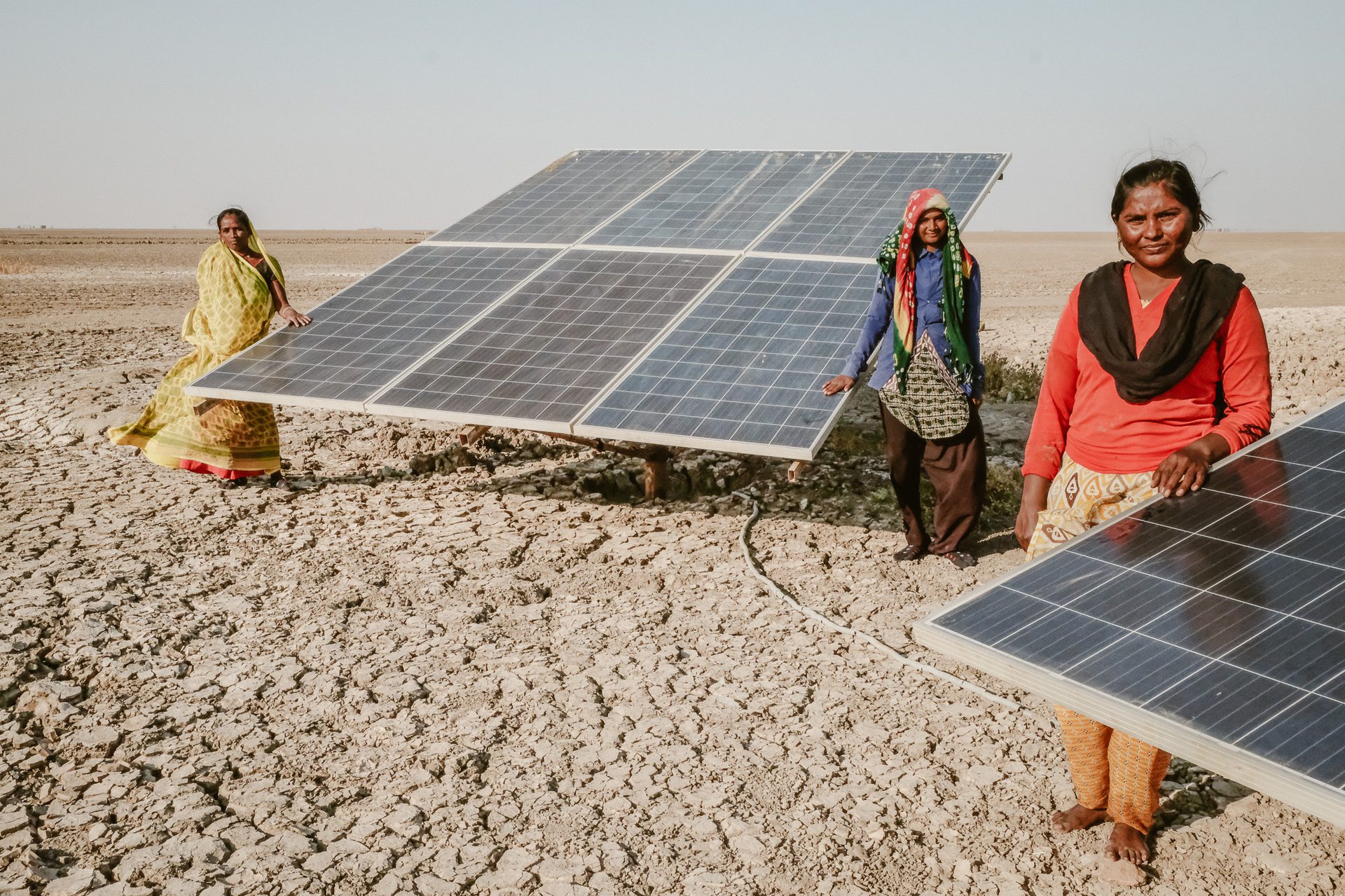
Manguben (far right) and her sisters next to their family’s solar panels. (Credit: Oliver Gordon / IHRB)


